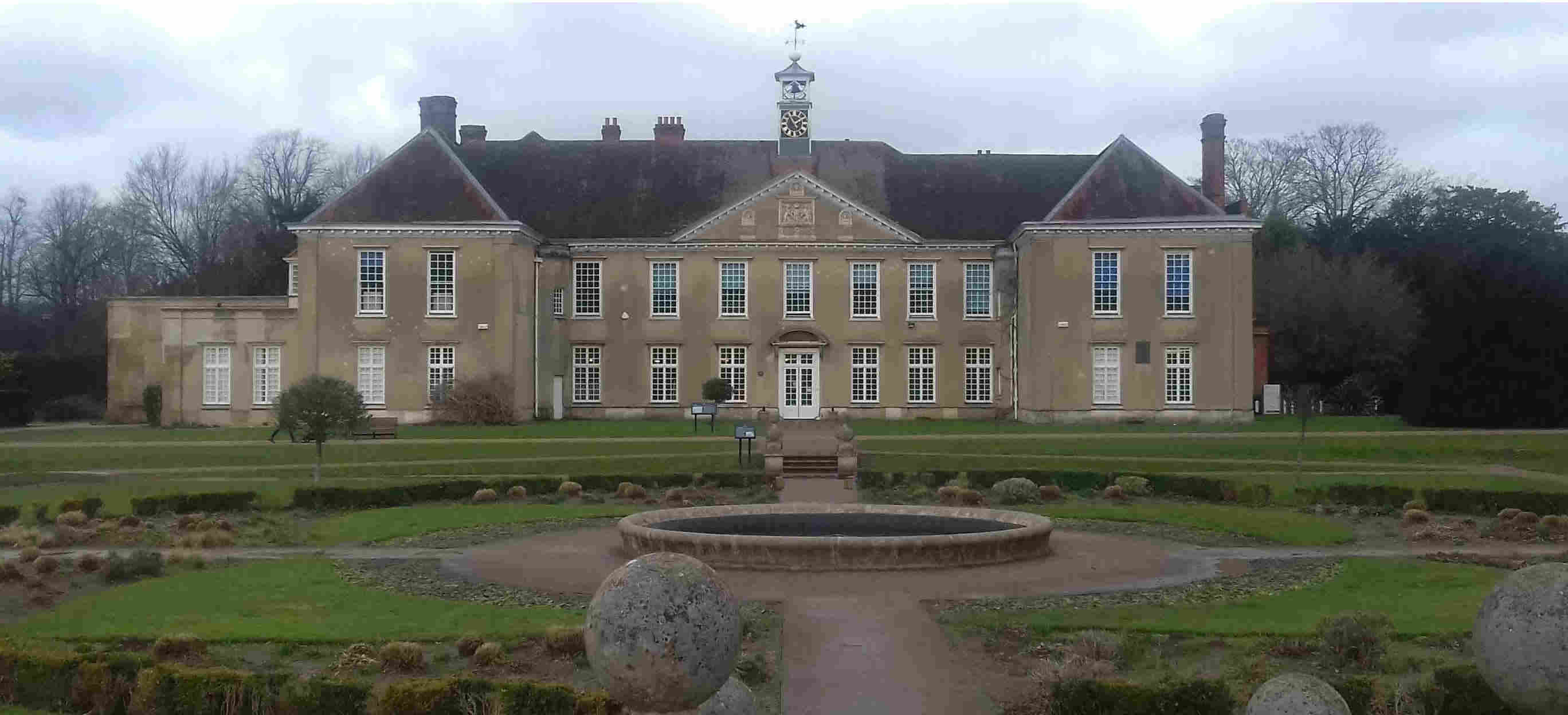Magazine
no.34 of March 1918 lists the teaching staff of the boys'
school as -
| |
Headmaster and Chaplain |
|
The Rev. Dr Perry
|
| |
|
Second Master |
|
Mr F.W. Jones
|
| |
Assistant Masters |
|
Mr G.Carpenter, Mr
G.W.C.Green and Mr J.L.E.Jones
|
| |
| |
Organist and Music Master |
|
Mr R.M.Price (shown as absent on
military service)<
|
| |
| |
Temporary Music Master |
|
Mr C.Small
|
| |
| |
Student Teachers |
|
Mr T.E.O.Cole and Miss Frances
Gamon
|
| |
| |
Sergeant |
|
Sergt. Major Gilchrist
|
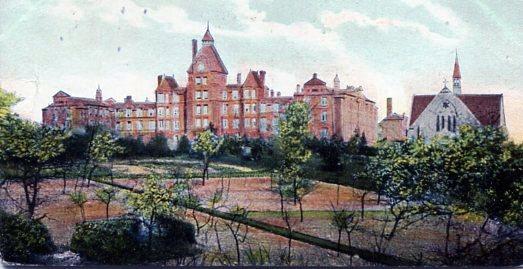 |
A St Anne's postcard that was
used in 1909. It was sent by someone employed there as
the message on the back reads, , 'The
infirmary where I am is not shown. This is a huge place -
400 boarders. Boys and girls are children of gentry in
reduced circumstances. The infirmary where I am nursing
is not shown - consists of 40 beds with a
siter-in-charge. I have ten girls, all with very slight
diptheria; very nice girls but rather a handful. . . . .
. . . Have other children. It seems to be an awfully
pretty district. Shall be able to tell you more next
time.'
Very slight
diphtheria? Diphtheria in its worst form restricts
breathing but a milder form is restricted to the skin
with lesions forming. Either way it was a nasty bacterial
infection that has thankfully been eradicated through
vaccination. As it is spread by breating in the bacteria
it is wondered if the ten patients should have been
isolated instead of being in a 40-bed ward. It would be
nice to be able to read any subsequent postcards sent. It
would also be nice to know the identity of the sender who
signs herseld simply EA. |
| |
| |
| |
Further down this page photos of some of
the pupils at St Anne's appear but very little is known
about individuals. |
|
| |
| |
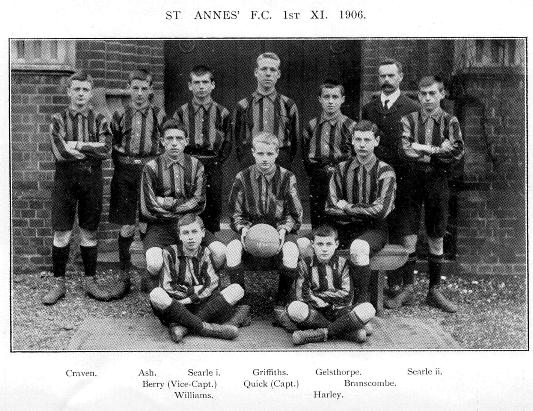 |
| St Anne's 1st
XI 1906 CRAVEN - ASH - SEARLE (i) - GRIFFITHS -
GELSTHORPE - SEARLE (ii)
BERRY (Vice Capt) - QUICK (Capt) - BRANSCOMBE
WILLIAMS - HARLEY
The master is Mr Blackall
|
| |
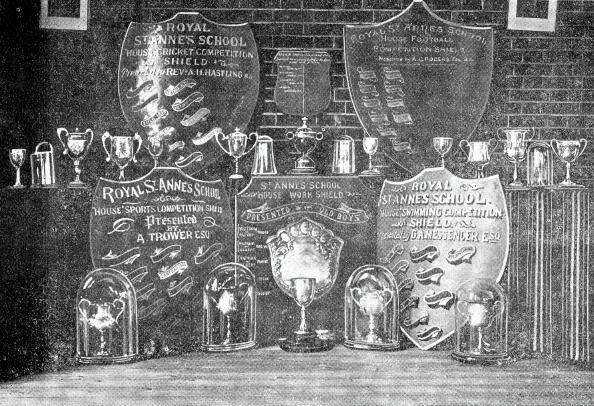 |
St Ann's
trophies awarded 1897-1907
(Courtesy
M.Ingram) |
| |
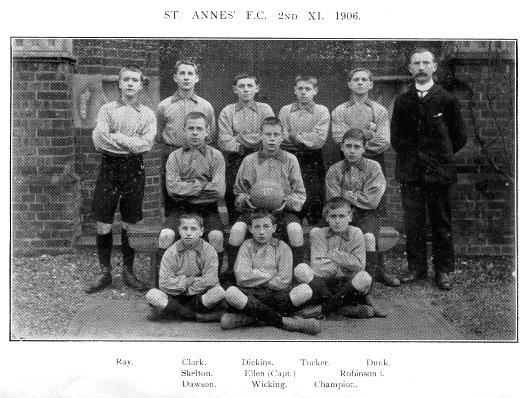 In1912
recommendations were made to change the name to 'St
Anne's Schools' in order to attract a better class
(probably in educational terms) of children. This is when
the 'e' was added to 'Ann' in accordance with the custom
of spelling the name at the time. In1912
recommendations were made to change the name to 'St
Anne's Schools' in order to attract a better class
(probably in educational terms) of children. This is when
the 'e' was added to 'Ann' in accordance with the custom
of spelling the name at the time. Right: - The football 2nd XI of 1906
Ex-pupil
Edward Pulling
No doubt many St Anne's boys went on to become
notable people in their fields. Most originated from
places other than Redhill but one, Edward Laston Pulling,
although born in Sidcup in 1890, a pupil at St Anne's
from 1902-1905 following the death of his father, stayed
locally after leaving school to live and work. With
addresses in Blackborough Road and Albion Road, Reigate,
and Fengates Road, Redhill, it would seem that he was
mainly in lodgings. He worked at Reigate Post Office for
some time as a sorter and telegraphist but his interest
in wireless telegraphy eventually led to him joining the
Government wireless service and being stationed on the
East Coast. Because of his value to the service he was
unable to get released to join the armed forces on the
outbreak of war in 1914 but the following year he
obtained a commission in the Royal Naval Air Service. His
fame arose from his part in a 1916 night-time attack that
destroyed a zeppelin that was returning to Germany over
the North Sea after dropping bombs in the area around
Barnsley for which he was awarded the Distinguished
Service Order. A Flight Sub-Lieutenant at the time he was
later promoted Flight Lieutenant but died in the wreckage
of his aeroplane in March 1917. An in-depth article about
Edward Pulling by David and Amelia Holdstock is included
in the local book 'A Celebration of Fengates Road', by
Andrew and Sarah Lewis.
|
| |
|
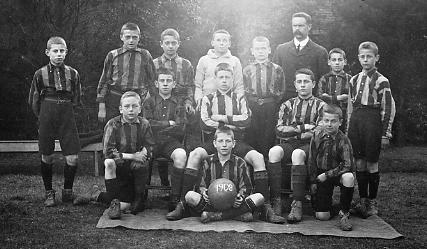 |
The
1907-1908 Victoria and Albert house football team |
| |
|
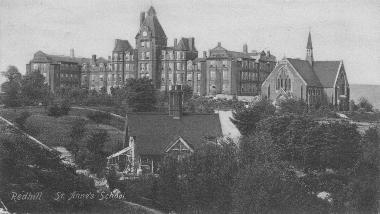 |
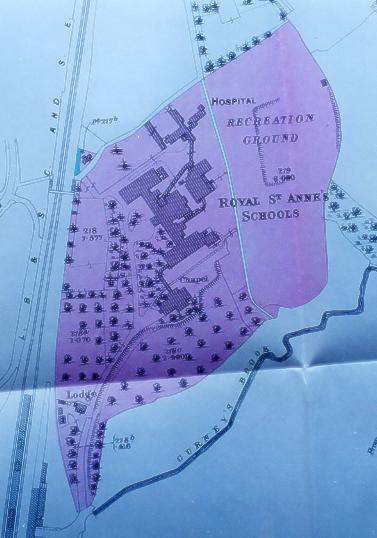 |
| This post card featuring the
school was postally used in 1907 and shows the chapel on
the right and the cottage in the grounds |
The railway line ran along St
Anne's western border (the station is bottom left). The
fastline is just off this map to right (east) side. |
| |
|
 |
| A picture (sadly damaged) of
the St Anne's boys in June 1908 |
| |
| More pictures from 1908 |
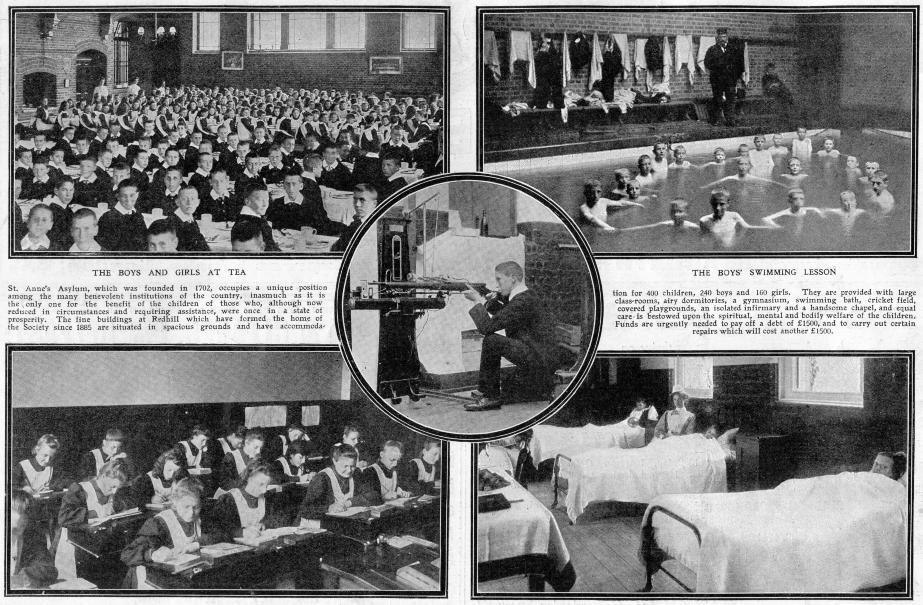 |
| Top left
- The Boys and Girls at Tea |
Top
Right - The Boys' Swimming Lesson. |
| Centre - Learning to Shoot |
| Bottom
left - A Girls' Classroom |
Bottom
right - The Sanatorium. |
| |
| The
text with the above photos extolls the benefits of the
school. The caption (not shown) said what a worthwhile
charity the St Anne's Society was. The text also says
that £1,500 is needed to pay off a debt and another
£1,500 was required for urgent repairs. |
| |
|
Closure of
the School
The history of the St Anne's Society spanned 210
years, whereas the school lasted at Redhill for only 35
years of that time. It finally closed just after the
Great War due to loss of income sufficient to keep it
going. A factor in this state of affairs may have been
the loss of the royal patronage it had previously
enjoyed, as after King Edward Vll died King George V
would not continue as he felt that other post war matters
were more urgent. A page from the St Ann's boys' Easter
term magazine of 1910 commemorated the death of King
Edward VII; little would the School authorities have
realised the effect upon St Ann's his passing was to have.
During the war the subscriptions to the school had
dropped while costs had increased. The number of children
also dropped with 124 boys and 106 girls there in 1918
and there was a budget deficit of £6,500. The school did
not go without great efforts to save it, and the failure
to raise £50,000 in 1919 resulted the situation becoming
a lost cause. A decision sell the property was made and
the school closed in the same year. |
| |
| | 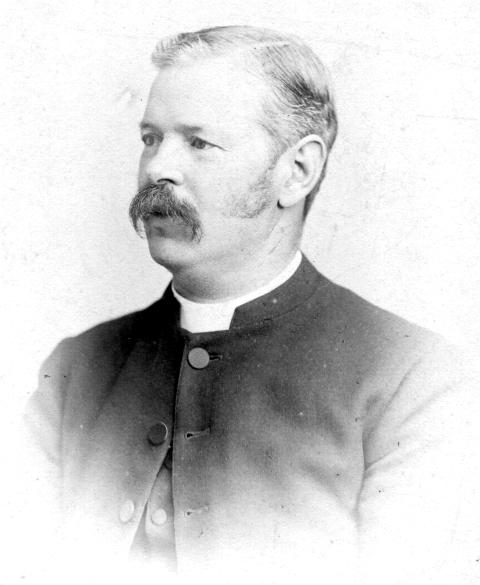 |
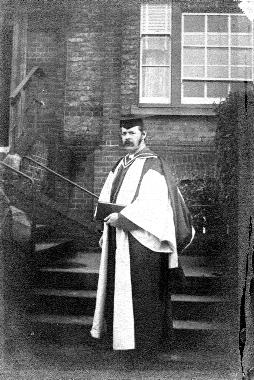 |
| |
Two portraits of Dr Perry in
his days as head of St Anne's
(Photos
courtesy Joanna Parkinson, Dr Perry's Great
granddaughter)) |
More about Dr Perry
Dr Perry had remained as Head and Chaplain since
his 1896 appointment and for seven years after the
closure lived at 'Cleveden', 41 London Road, Redhill,
doing private tuition. In 1924 Hillsbrow School at
Redhill was advertising 'the Rev. W.J.Perry' as one of
its staff members. In 1926 he became Rector of Farleigh,
near Warlingham and also rector to Croydon Mental
Hospital until his retirement in 1936. His wife died in
1933 and he died at Ramsgate in 1949 aged 90, seven weeks
after the death of his son. Five daughters survived him. |
| |
|
Mr
Anthony Miller brought to the attention of this page that
he has a book ‘THE INTERMEDIATE
HISTORY OF ENGLAND (Political, Social and Constitutional)
(2 Vols.), by W. J. Perry. [J. M. Dent & Sons,
Limited]. A note on the title page that it is by WJ Perry of
St Anne’s School Redhill published 1909. A 1909 date coupled with the ‘St
Anne’s’ reference would make it seem that
W.J.Perry senior was the author. His son, also W.J.Perry,
was 21 in 1909 which seems a little young to be
publishing such a work, something that would have taken
several years to research and complete so would have had
to have been started in his teens.
Many thanks to Mr Miller for this information. |
| |
|
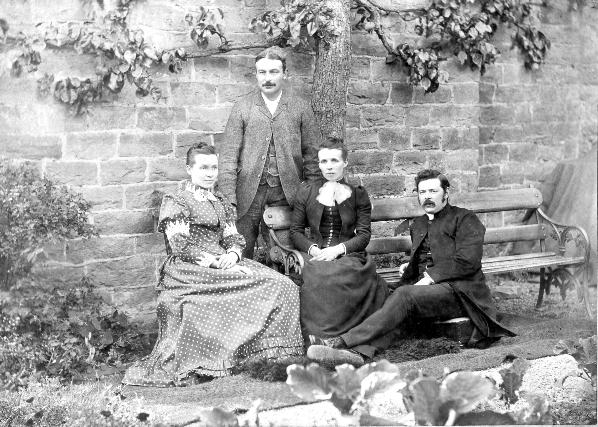 |
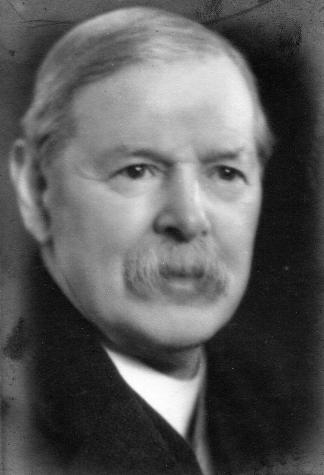 |
| Dr Perry with his wife Sarah (far left)
and another couple |
Dr Perry in later life |
| (Photos courtesy Joanna
Parkinson, Dr Perry's Great granddaughter)) |
| |
| Information
emailed from Nicole Duhamel, a great-great-granddaughter
of Dr Perry. 'The photograph above showing Dr
Perry and his wife shows an “unknown couple”.
Based on the resemblance between Mrs Perry and the
unnamed woman, I would suggest that the unknown woman is
one of her sisters – probably Louisa or Caroline,
the only two who married. This would make the unknown man
either William Roberts (Louisa’s husband) or George
Bright (Caroline’s husband).' Thank you
for this information. AJM |
| |
|
| The 1891 census shows
William and Sarah Perry both aged 31 and living at
Hackney. William is a Clerk in Holy Orders and a
schoolmaster. They have three children - Alice aged 6,
Sarah aged 5 and William aged 3. |
| |
| The 1901 census shows
William and Sarah both aged 41 and living at St Anne's,
Redhill. William's occupation is the same. Four children
are shown - William aged 13, Dorothy aged 7, Kathleen
aged 6, Evelyn aged 4 and Norah aged 2. |
| |
| Some time after 1901 a
seventh daughter, Helen, was born |
| |
| |
| W.J.Perry Junior |
| |
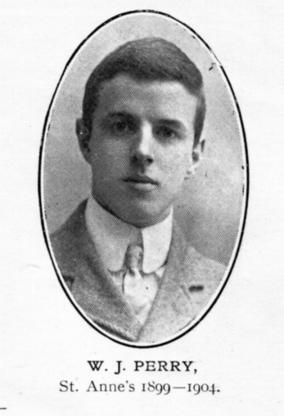 In the St Anne's
school magazine for 1908/9 there is a picture of St
Anne’s Headmaster W.J.Perry's son, also W.J.Perry.
He is one of four boys supporting themselves at Cambridge
on scholarships they won after leaving St
Anne’s. In his letter (apparently an address
given in each magazine) Headmaster W.J.Perry writes: ‘We
have all been pleased to think that four of our old boys
were up for honours exams at Cambridge University this
year. I believe that this event has never happened in the
history of St. Anne’s. These four boys have made a
good beginning. I should like to add to what your editor
has stated that W.J.Perry also gained the English prize
essay two years in succession at Selwyn College, a record
I believe for a mathematical student.’ (He then
goes on to talk about the other boys). In the St Anne's
school magazine for 1908/9 there is a picture of St
Anne’s Headmaster W.J.Perry's son, also W.J.Perry.
He is one of four boys supporting themselves at Cambridge
on scholarships they won after leaving St
Anne’s. In his letter (apparently an address
given in each magazine) Headmaster W.J.Perry writes: ‘We
have all been pleased to think that four of our old boys
were up for honours exams at Cambridge University this
year. I believe that this event has never happened in the
history of St. Anne’s. These four boys have made a
good beginning. I should like to add to what your editor
has stated that W.J.Perry also gained the English prize
essay two years in succession at Selwyn College, a record
I believe for a mathematical student.’ (He then
goes on to talk about the other boys). The
editor, in his notes referred to above, says: St
Anne’s should be proud, for in this year no less
than four boys who, not long ago, have been wearing forms
etc. out in the VI.a Classroom, have been taking part in
the various ‘Tripos’ Examinations at Cambridge.
(He then mentions how the other three boys have done so
far). ‘To W.J.Perry –
“Sticks” – was allotted the severest
task, and although he did not achieve the success we all
wished him to achieve, he nevertheless achieved a very
fine performance in coming out 35th in the
Mathematical Tripos. There was very keen competition this
year because it was the last opportunity given to men of
becoming Senior Wranglers’.
NOTE 1 - According to
Wikipedia at the University of Cambridge a Wrangler
is a student who has completed the third year (called Part
II) of the Mathematical Tripos with 1st class
honours. Until 1909, when the class list ceased to be
published in rank order, the highest-scoring student was
named the Senior Wrangler, the second
highest-scoring student the Second Wrangler and so
on. At the other end of the scale, the person who
achieved the lowest exam marks, but still earned a
third-class degree, was known as the wooden spoon. The term
'Senior Wrangler' is said to have become synonymous with
academic supremacy. Obtaining the position of a highly
ranked Wrangler created many opportunities for the
individual's subsequent profession.
|
| |
|
|
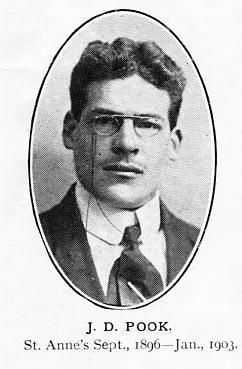 |
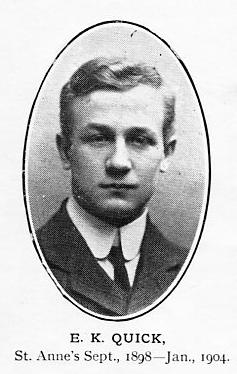 |
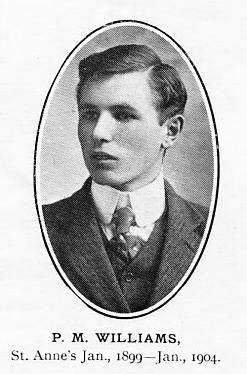 |
| The other
three boys supporting themselves at Cambridge on
scholarships they won after leaving St Anne’s. |
| |
|
|
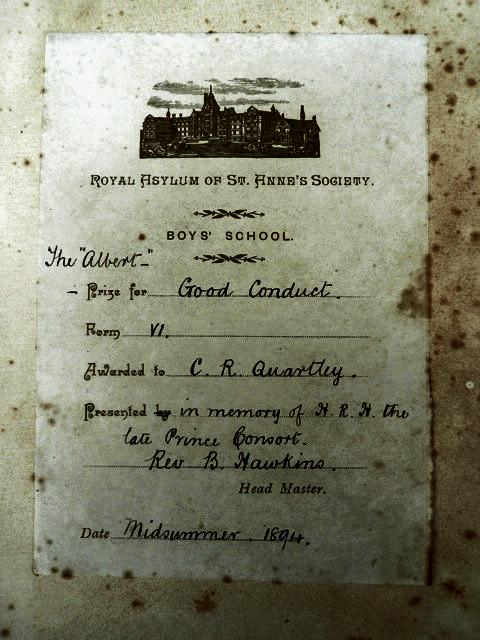
Another St Anne's pupil.Elizabeth Smith
sent this good conduct certificate made out to her
grandfather Cecil Reade Quartley, which is signed by the
then headmaster, Mr Hawkins, in 1894. Elizabeth also sent
the photos of her grandfather below.
|
| |
|
|
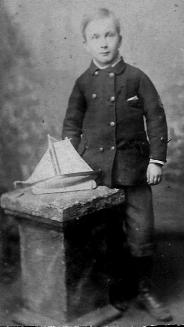 |
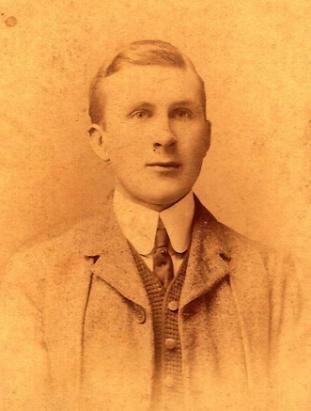 |
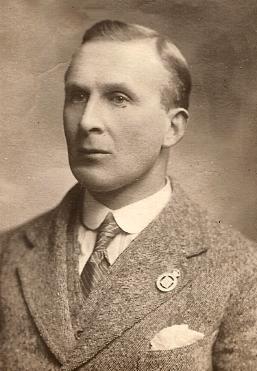 |
| Cecil Reade
Quartly is shown here as a boy, as a young man not many
years after leaving St Anne's and in his later years. He
lived at 1 High Street, Waddesdon, Buckingham. His father
died when Cecil was 3 years old and he was sent to St
Anne's at some point after that. Cecil worked at
George Spencer Moulton & Co (India Rubber Works) as
the works manager in Bradford -on-Avon, Wiltshire. (His
granddaughter has an Army Reserve, Scheduled Occupation
Certificate dated 9 May 1917 to say he was at the rubber
works at that time). He died at Saltford, Nr Bath,
Somerset on 17/1/1951 aged 70 years. Grateful thanks to Elizabeth Smith for the
good conduct certificate and photos. |
| |
|
|
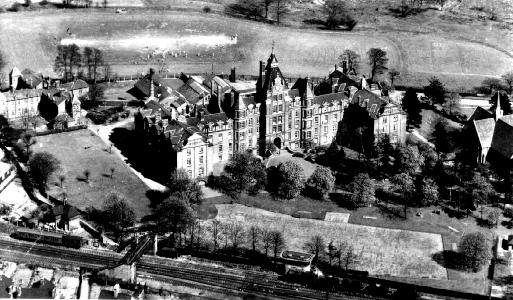 An aerial
picture of St Anne's with the London to Brighton railway
slow line at the bottom of the picture. The field behind was the School's
playing fields but was later the Technical College
playing field. The Warwick School has now been built
here. The London to Brighton fast (or quarry) line was
built just beyond and between the two was boggy ground
that has been drained and had houses built upon it. Boys
can be seen on the playing field behind the building. The
picture was sent by Graham Bartlett whose grandfather,
Bert Bartlett, worked at St Annes as a boilerman /
handyman and met his second wife, Mary Fletcher there,
who was a cook. The picture, which was on a postcard was
discovered among his possessions after he died in 1989. Thanks
for the picture and information, Graham. An aerial
picture of St Anne's with the London to Brighton railway
slow line at the bottom of the picture. The field behind was the School's
playing fields but was later the Technical College
playing field. The Warwick School has now been built
here. The London to Brighton fast (or quarry) line was
built just beyond and between the two was boggy ground
that has been drained and had houses built upon it. Boys
can be seen on the playing field behind the building. The
picture was sent by Graham Bartlett whose grandfather,
Bert Bartlett, worked at St Annes as a boilerman /
handyman and met his second wife, Mary Fletcher there,
who was a cook. The picture, which was on a postcard was
discovered among his possessions after he died in 1989. Thanks
for the picture and information, Graham.
|
| |
|
| Photos of pupils and staff
dating from 1913-18 from albums handed down through
generations of the Perry family are shown on a separate
page. Many of the subjects are named. Previously no
pictures of girls or female staff at St Anne's had been
seen. Grateful thanks to Joanna Parkinson and her husband
Stephen for making them available. |
| |
|
| View the photographs on the next page |
| |
|
| |
|
| |
|
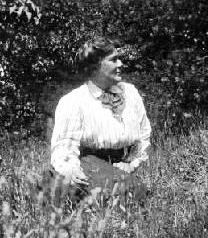 |
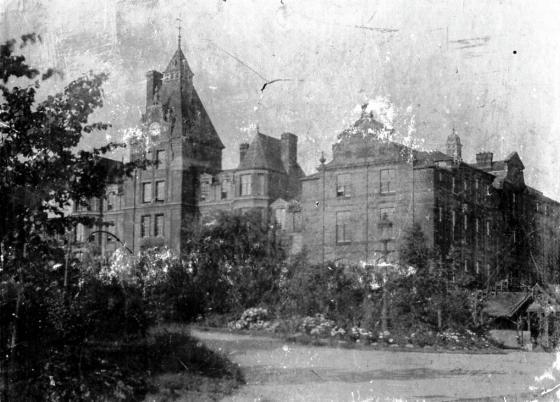 |
| The lady in a field is Miss
J.M.Young, headmistress of St Annes 1906-1919. - (Photo courtesy Joanna
Parkinson) |
An unusual angle on St Annes,
date unknown.
(Photo
courtesy Joanna Parkinson) |
| |
|
| |
|
1919 -
1935 St Anne's Becomes the Foundling Hospital
Following the closure of St Anne's as the St Anne's
Society the building was offered for sale by auction in
1920 but remained unsold. In 1921 another auction
disposed of the furniture and fittings, amongst which
were 400 iron bedsteads, 1,500 blankets and 21 pianos.
The building remained empty and for sale at £30,000 for
seven years until, in 1926, it was purchased by the
Foundling Hospital, although the lower sum of 25,500 was
paid. The Foundling Hospital was an organisation almost
as old as the St Anne's Schools that was started in 1739
by Captain Thomas Coram, who had been shocked to see
abandoned babies lying either dead or dying on London
rubbish heaps. He obtained a royal charter to start a
hospital to take in these infants, the success of his
venture owing much to the support of the painter, Hogarth
and the composer Handel. The Foundling Hospital continued
into the 19th century when it found the smoke and soot in
London's air too much to contend with and moved out to
Redhill. St Anne's, the building, had a new occupier. In
many respects the organisation was on a par with that
other famous guardian of orphans, St Barnardo's, but the
main difference as far as the Redhill children were proud
to point out was that they had uniforms and St Barnardo's
children did not. The children made a colourful sight
when they were out together in the town, 'crocodiles' of
them weaving their way along the pavements.
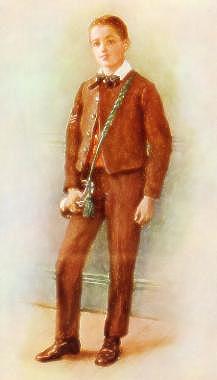 |
|
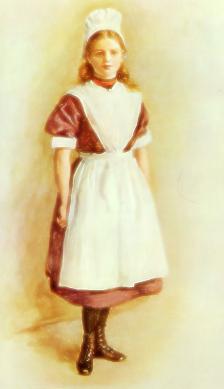 |
| A Foundling Boy |
|
A Foundling Girl |
| Pictures from a pair of postcards
depicting paintings by Harold Copping contained
in papers of Beryl Watson |
The
move to Redhill had always been intended as a temporary
one for the Foundling School as it was having permanent
premises purpose built at Berkhamstead. These were ready
by 1935 when the school was transferred away from St
Anne's, which once again became empty. The Foundling
School was not to remain in its new home for much longer,
however, as modern thinking was to move away from
children's institutions towards foster homes. This was
achieved and in 1950 the Berkhamstead site was sold to
Hertfordshire County Council. Five years later the
Foundling Hospital changed its name to the Thomas Coram
Foundation for Children, and continues to work for
children with special needs.
|
| Pictures
below: - King George V had remained a patron
of the Foundling School and in 1929 his daughter, the
Princess Royal, Princess Mary, Countess of Harewood,
became a governor of the institution. On July 12th 1930
she combined a visit to the East Surrey Hospital on
Whitepost Hill with a visit to the Foundling School at St
Anne's. Photos of this visit are understood to exist in
the Thomas Coram Museum in London; four photocopies from
Beryl Watson's papers appear below. The children are
wearing their traditional costumes which may have been
used only on formal occasions by this time. Beryl Watson
remarks in her notes that the girls' dresses in the
pictures are considerably shorter than she remembered
seeing them in 1927, no doubt following the current
fashion. |
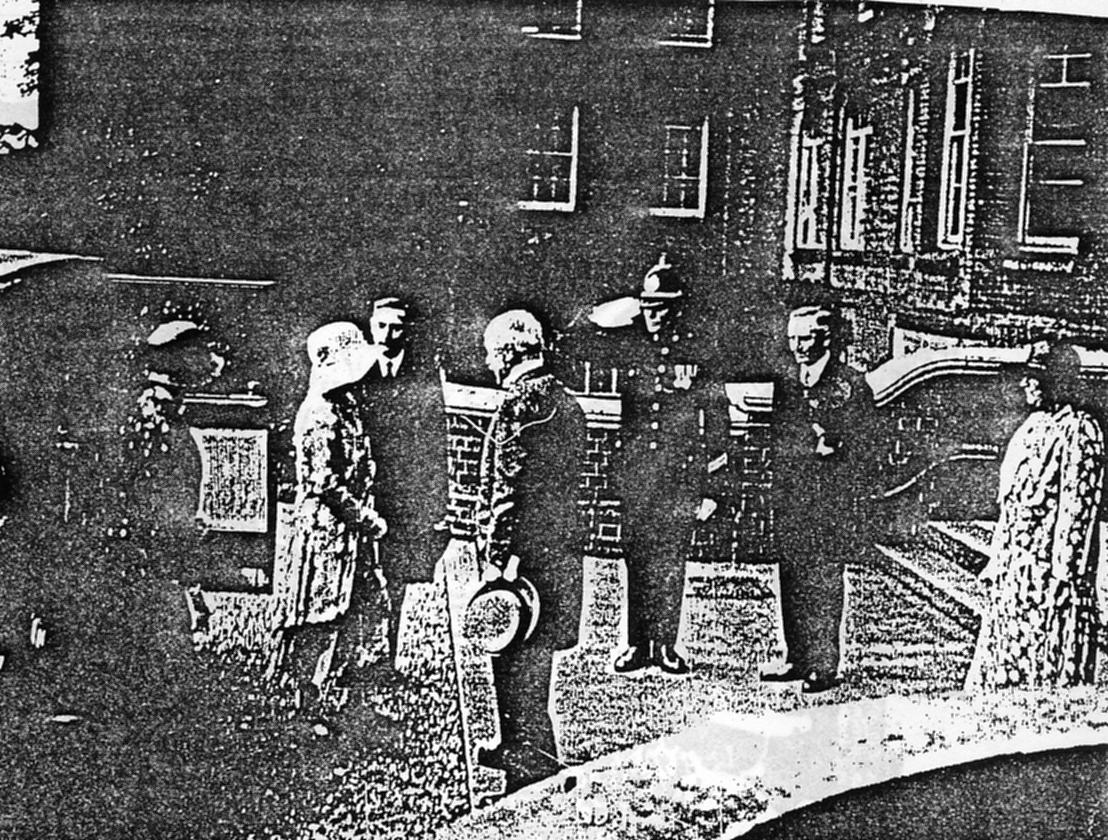 |
|
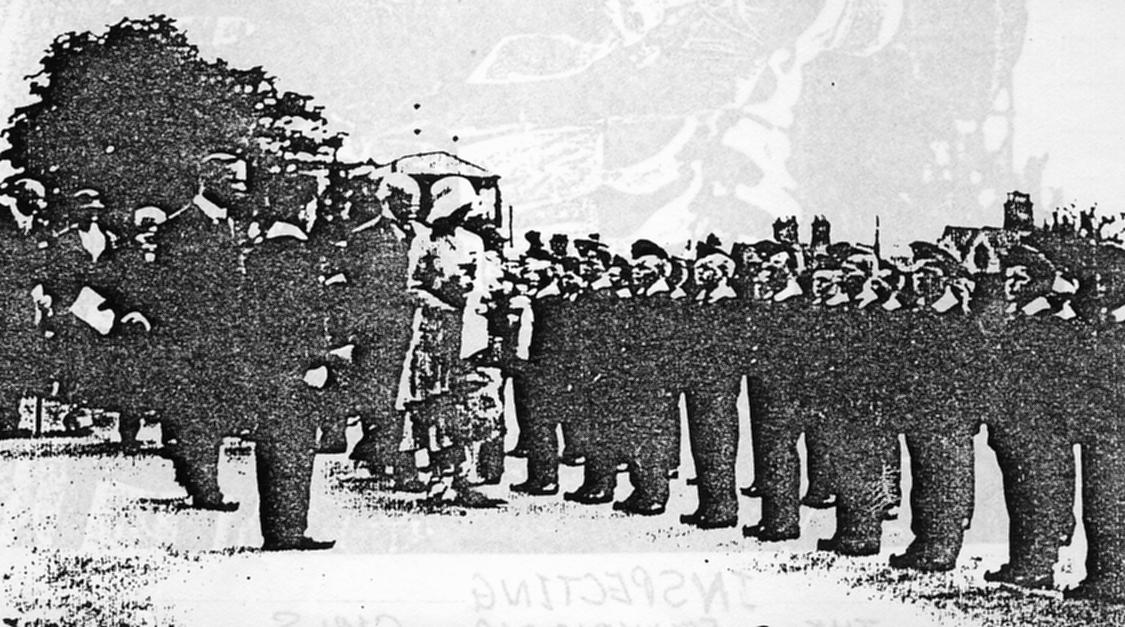 |
| 1930
visit to the by the Princess Royal, Princess Mary,
Countess of Harewood. Here she is arriving. |
|
The boys
lined up for inspection |
| |
|
|
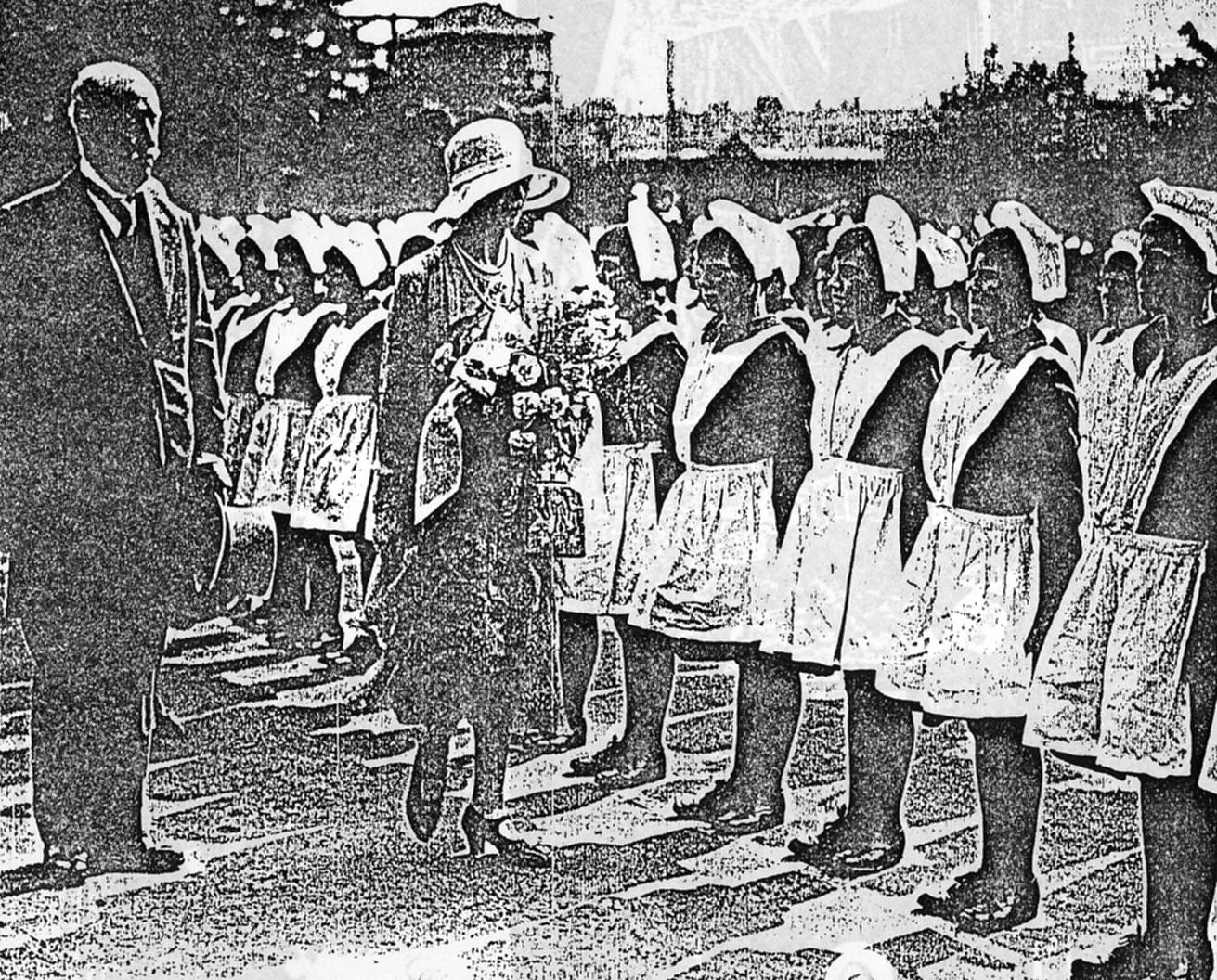 |
|
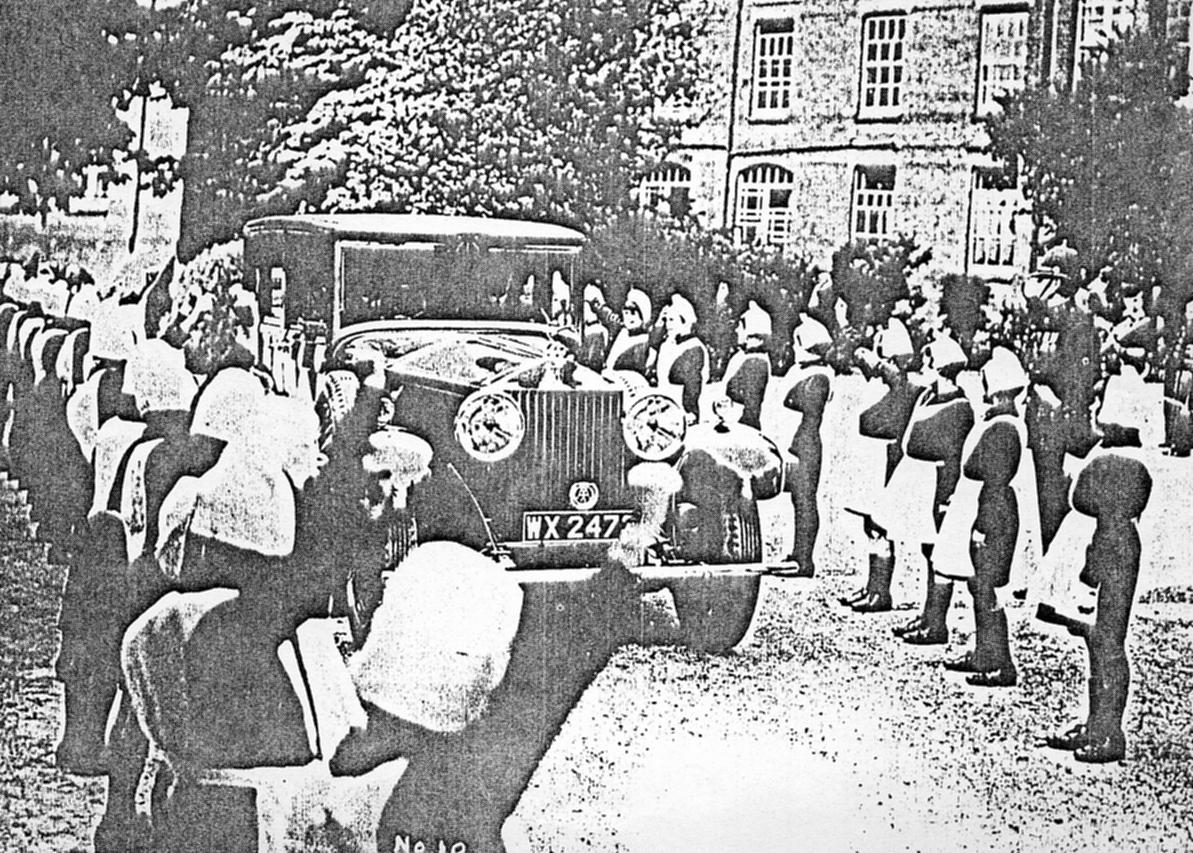 |
| HRH
inspects the girls and is waved off as she departs. No
doubt there was much more to her visit than is shown
above. |
| |
|
|
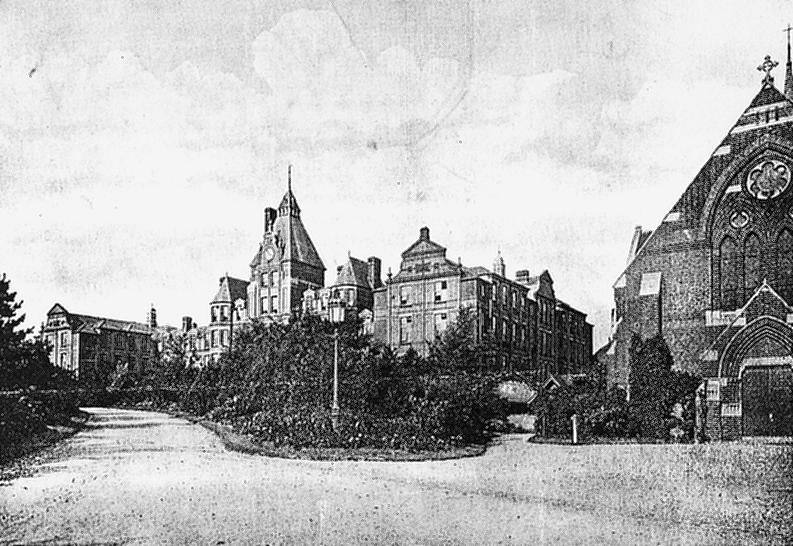 |
|
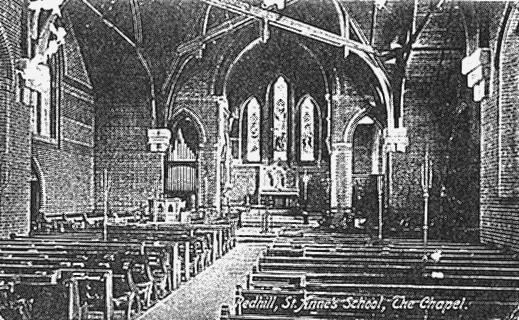 |
| A view of St
Anne's showing the chapel on the right |
|
The
chapel interior (Jan
Dixon and Roger Clarke) |
|
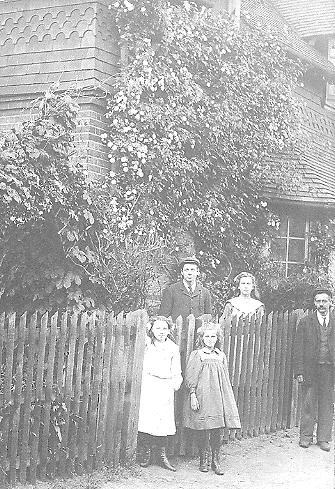 A St Anne's Engineer A St Anne's Engineer
Christopher Francis Gough's occupation was given on
his 1882 marriage certificate as 'Engine Driver' but it
seems that an interpretation of this that would have him
on the footplate of a locomotive, although a natural
assumption, would be incorrect. This is because for some
time he was an 'Engine Driver' at the printing works in
the Brighton Road, before he went to work at St Anne's
and to live there in the Engineer's Cottage. It seems,
then, that 'Engineer' would be a better description for
this man who would be in charge of the machinery and
other equipment for which either a printing works or a
large institution would require a skilled technical man.
Engineer Gough's time at St Anne's started around 1893
and continued until at least 1923. The fact that this
latter date is four years after the St Anne's Society
left the premises is perhaps explained either by the need
for the engineer to remain on site to maintain the fabric
and general workings of the building or that he had some
kind of secure tenancy in the Engineer's cottage. It
would be wonderful if we had some detailed insight into
the kind of work he did in the huge building but that is
denied us. What we do have is an insight into some work
he did during WW1 and which is revealed in a letter to a
daughter. 'I have been keeping vigil on the railway
bridge until we got the all clear for the school. We
could see the barrage and hear the bursting of the
shells, and they have been in our neighbourhood but did
not drop any shells. Two of our airmen were chasing
Gothers (sic) across cricket field. Our machines
had strong headlights (electric). It was weird; we could
hear the Germans but could not see them. There were the
two Mr Greens, Mr Jones , myself and two or three town
special constables on the bridge, quite enough of us
don't you think. Keeping watch in case of anything, but I
really don't know what any one of us could have done. St
Anne's children were mustered in the basement corridors,
three concrete floors above them, but some nights they
were allowed to remain in bed, but were to hold
themselves in readiness to turn out sharp. Wasn't I glad
when I see the weather, mist vapour and cloud, come
streaming across the sky from the south-west and cover up
the big glaring face of the moon last night'.
(The word 'Gothers' no doubt
refers to Gothas, large biplanes specially built by the
Germans to bomb London and other British towns in
daylight after the failures of the zeppelins. They came
in numbers and the first attack by them was in May 1917.
Losses, some due to bad weather, caused the Germans to
revert to night raids, especially when there was a bright
moon). This part of the history of St Anne's serves to
show us how the welfare of the children was being
observed as best it could be in such circumstances. The
letter also contained words of encouragement to his
daughter in London, the main target for the raids of the
aeroplanes that Engineer Christopher Gough had heard but
not seen.
The picture above shows Christopher Gough (far
right) outside St Anne's Engineer's Lodge with four of
his own children in about 1907 (Picture,
letter and details of Christopher Gough and other
information courtesy Jan Dixon and Roger Clarke) |
| |
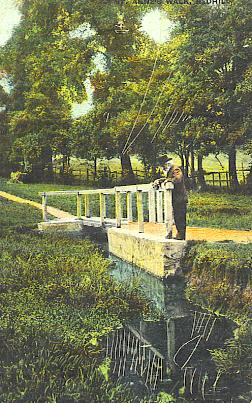 |
|
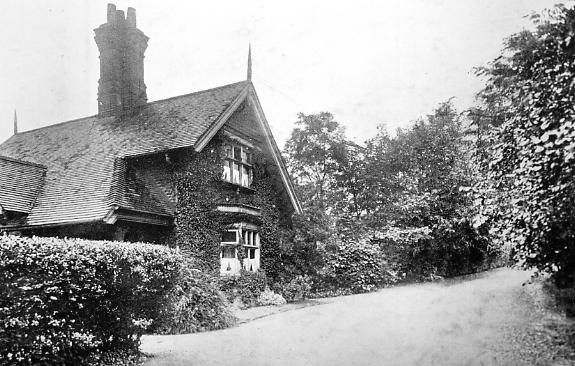 |
An image of St Anne's Walk from
an old postcard
(kindly
supplied by Diane Johansen) |
|
The cottage on the entrance
drive to St Anne's, presumably the one occupied by
Engineer Gough above. |
| |
St Anne's 1935 - 1975
St Anne's was sold to Surrey County Council by the
governors of the Foundling Hospital in 1936 following the
closing of captain Coram's Old Holborn institution and
the opening of a new school at Berkhamstead. The 1912
name, 'The St Anne's Schools', had been changed to 'The
Foundling School' during the years of that institution's
occupation of the building but now it was proposed that
the original name be re-adopted, although it was stated
at the time that the name was not 'St Anne's Schools' but
'St Anne's Institution'. The point was of little or no
significance however, especially as an alternative and
simpler 'St Anne's' was more favourable to most and was
how that building was renamed and known for the rest of
its life, and how it has been referred to ever since. The
building was to have one more use, however. There had
long been a consensus of opinion against the workhouse
system where many old people spent their last days.
Redhill's workhouse was on Earlswood Common, along what
was then Union Road but is now Pendleton Road. Surrey
County Council turned St Anne's into a home for the
elderly and closed the Earlswood workhouse in 1938. The
lot of the redbrick building's new residents was said to
be improved by their transference to a place where they
received care from dedicated staff. Later on the building
was also used to house the homeless. This was a state of
affairs which, it was said, could not last because the
word 'institution' could still be applied to the large
Victorian edifice and the purpose it served (despite the
word not having been officially adopted as part of its
name). Gradually the elderly were moved into smaller
units, this process being completed by about 1973. In
1975 there was a serious fire at St Anne's. There were
still some homeless families living there but Surrey
County Council, which was already considering the
building's future, now had £40,000 worth of damage to
influence their decision. That decision was to close the
building completely. The responsibility for housing the
homeless was being transferred to the Borough Council
anyway and they were eventually found other
accommodation. In fact the whole structure and funding of
this aspect of social service was altered.
|
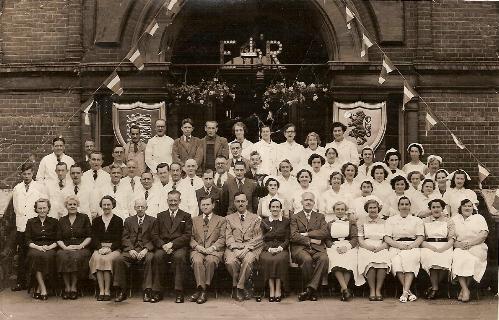 The
staff of St Annes, Redhill. By the look of the background
it must be Coronation Year, 1953. This picture courtesy
Brian Burrows whose wife's father, George Clark, worked
there from 1945-53. He is standing first on left at back
(head near flag)
|
| |
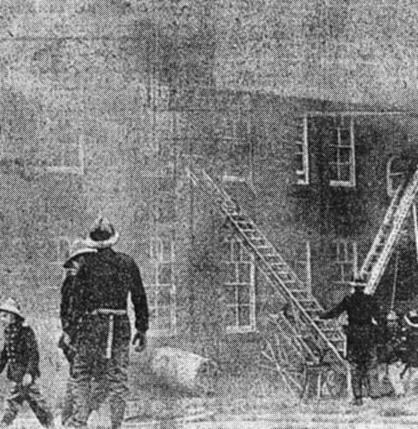 A fire that occurred at St Anne's in
April 1974 caused £40,000 worth of damage, it was
claimed. The building was being phased out as a centre
for the elderly at this time and the fire threw up
serious doubts about its future, doubts which were later
to become a firm decision for closure and redevelopment.
The picture shows fireman attending the fire in progress. A fire that occurred at St Anne's in
April 1974 caused £40,000 worth of damage, it was
claimed. The building was being phased out as a centre
for the elderly at this time and the fire threw up
serious doubts about its future, doubts which were later
to become a firm decision for closure and redevelopment.
The picture shows fireman attending the fire in progress.Author's
note: - St Anne's had for some time been
used by the Redhill fire Brigade as a practice point for
escape ladder drills, so local fireman were versed in
some aspects of fighting fire here. My own father was OIC
at Redhill Fire Station in the 1950/60s when a visiting
inspecting officer arrived unannounced and ordered a fire
escape drill on the spot. The firemen were turned out and
the escape was driven to St Anne's and efficiently run up
the front of the building, the repetition of an exercise
carried out many times before. The inspecting officer
went away satisfied. AJM
|
| Picture
courtesy Surrey Mirror |
The Final Ignominy
The St Anne's building then became the centre of
controversy as there were those who wanted it preserved.
It had been purpose-designed by our Victorian Civic
Fathers and was a focal point of the town, some argued.
It was a landmark of distinction and dignity and should
be recognised as such by being made a listed building.
Beryl Watson was reported in the local paper as saying it
would make a very good block of flats, although the same
article also reported opinions that Surrey County Council
had allowed the building to deteriorate too far during
the time it had stood empty. Even if most of it was
demolished the central tower with its clock turret could
remain as the centrepiece for a new development, it was
suggested. But this was not the only controversial aspect
of the building. The stained glass windows from the
chapel had been sold to a dealer and had disappeared. Why
had these not been preserved, people asked. But the
building was owned by the County, not by the Borough, and
in December 1987 it was demolished, anything of interest
or value being auctioned. There were two exceptions; the
first being the foundation stones of the main building
and of the chapel, which were left behind by the
demolition men and now lay behind one of the buildings in
Noake Drive. The other exception was the clock, which has
been refurbished and is now be incorporated in the Belfry
shopping mall in Redhill.. |
| |
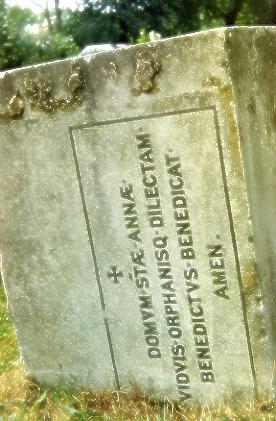 |
|
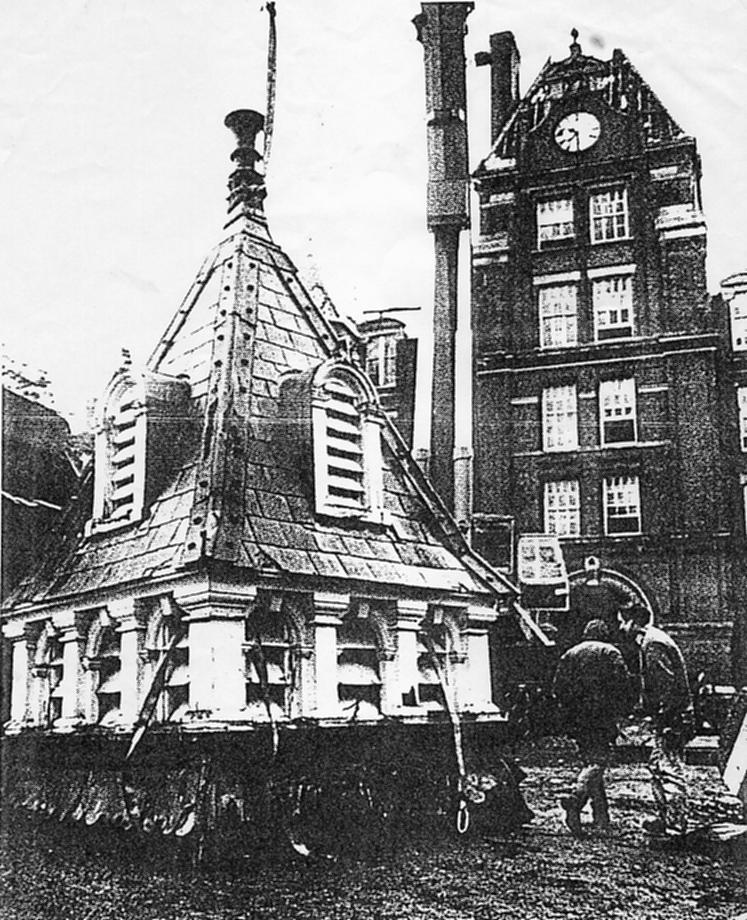 |
The foundation stone of the
chapel, laid by royal hand 1884, abandoned by demolition
men 1987.
(Photo taken by
author) |
|
St Anne's demolition - the
turret of St Anne's tower was rescued by the Sussex
Architectural Salvage Group. The clock can be seen in its
original position.
(picture
courtesy Beryl Watson, from a Surrey Mirror article) |
| |
|
|
| The Clock |
|
|
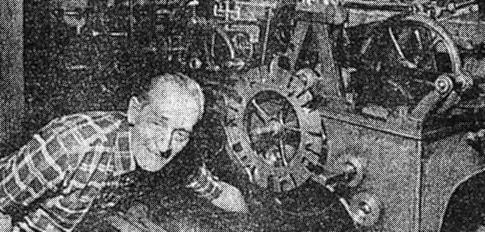
'Time
Runs out for St Anne's' was the local paper's apt
headline for a 1975 article about the stopping of the
clock after it had faced the town of Redhill for over 90
years. The picture shows assistant engineer Mr Maurice
Berkeley stopping the clock. Mr Berkeley had looked after
the clock for eight and a half years; perhaps it was one
of the tasks also carried out by Engineer Gough,
mentioned above, during his time there (Photo courtesy the Surrey Mirror) |
| |
|
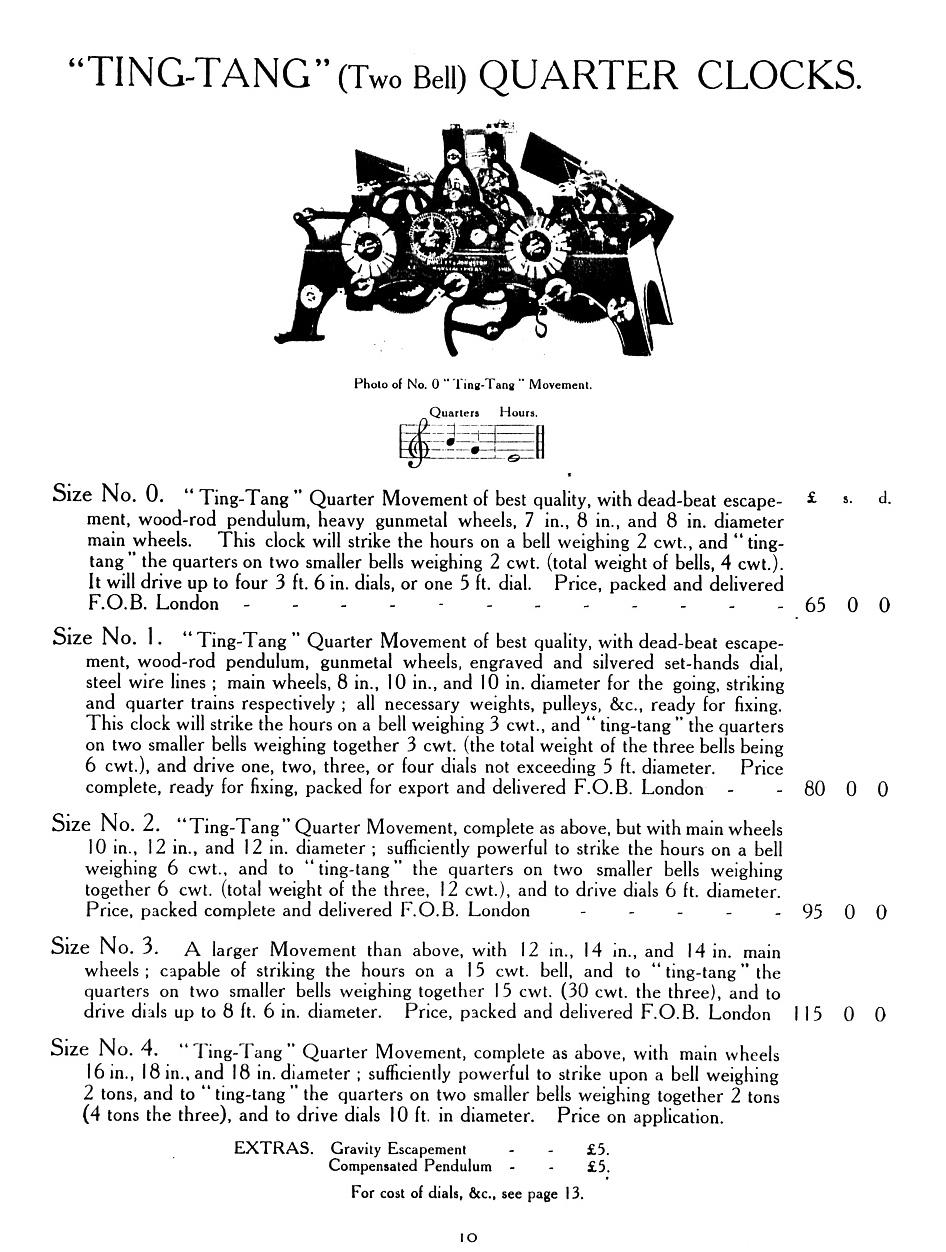 |
| Manufacturer's description of
their clocks available for purchase |
| |
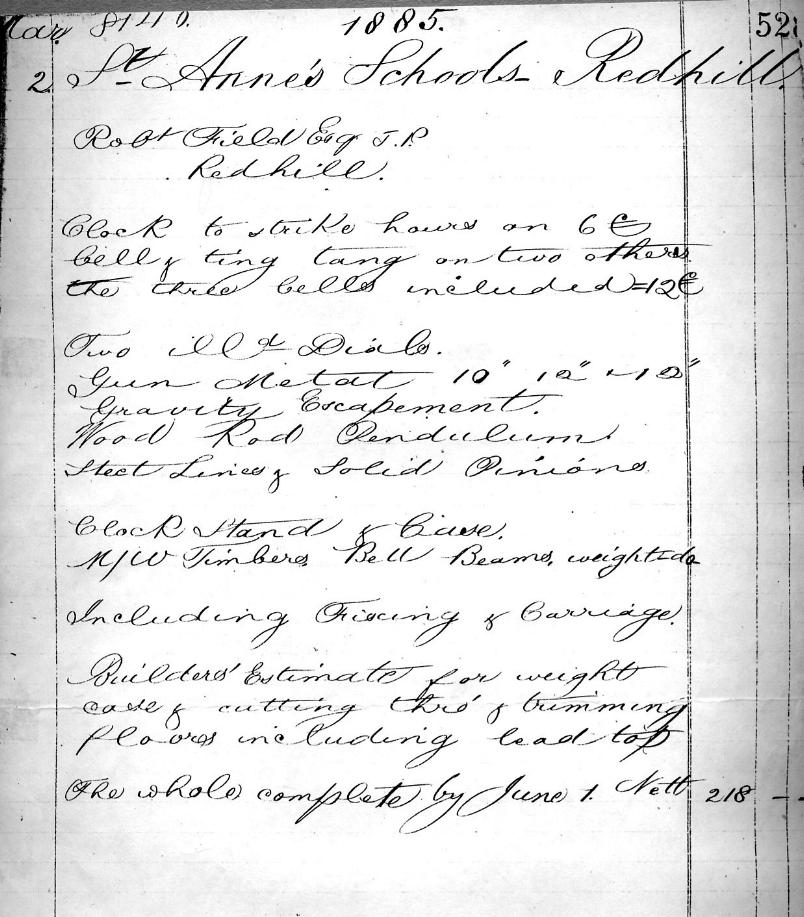 |
| The original order for the
clock made by Robert Field in 1885. (Courtesy James Bloomfield) |
| |
| The clock was restored and adapted
for a new life in the Belfry shopping mall in Redhill
High Street. The story of how this came about is told in
the Surrey Mirror article from 1988 (right) and the
photos below. |
|
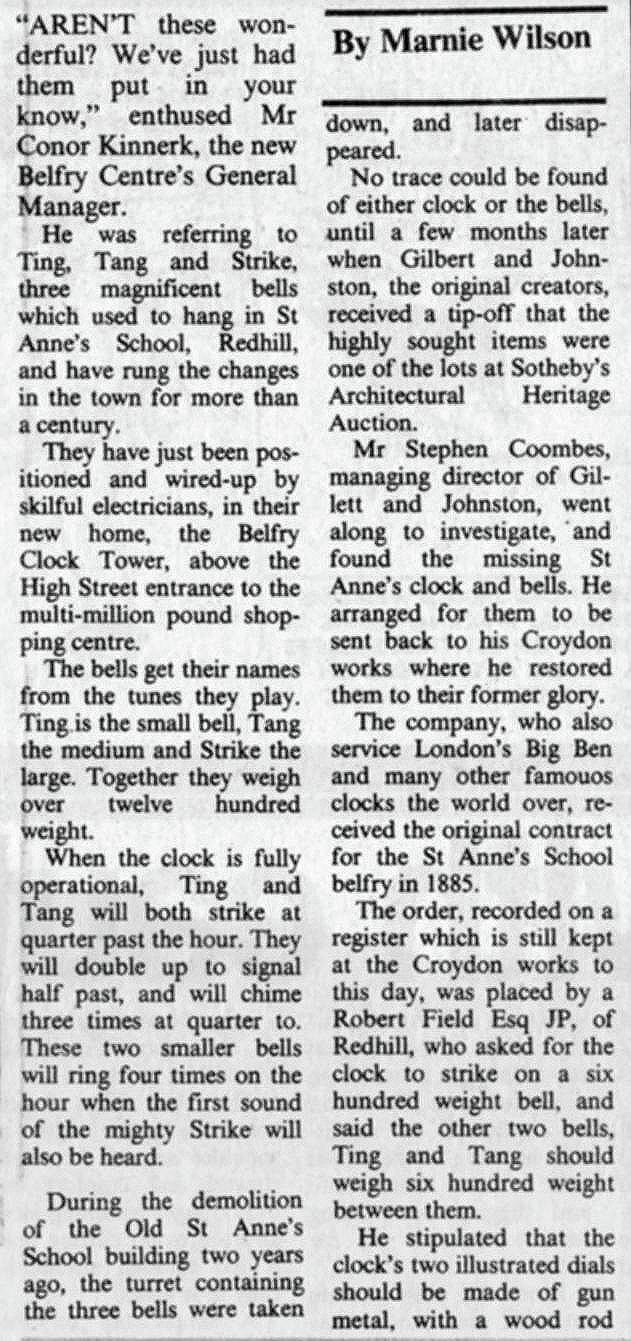 |
| |
|
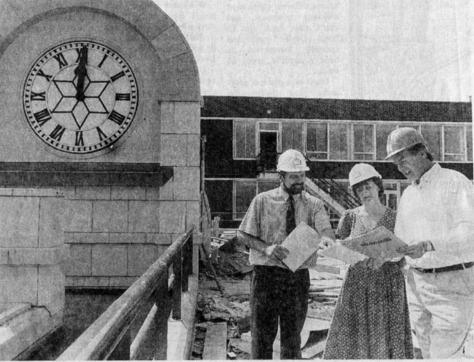 |
|
The clock in situ. Pictured
from l-r are Adam Godfrey, Divisional Director of Stiles
Harold and Williams, Maureen Cradock, Centre
Administrator at the Belfry, and Conor Kinnerk, Centre
Manager at the Belfry.
(Photo from
Surrey Mirror of August 1991 provided by James
Bloomfield) |
|
| |
|
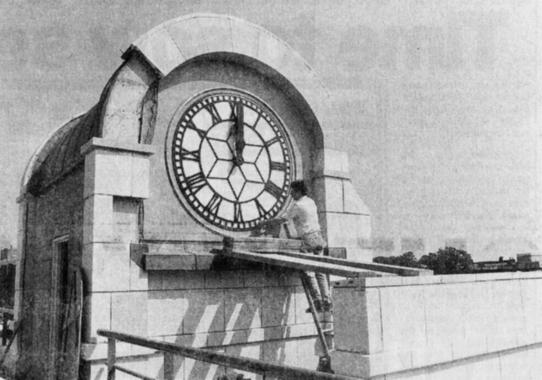 |
|
| Final touches to the
installation of one of the clockfaces.(Photo from Surrey Mirror of
August 1991 provided by James Bloomfield) |
|
| |
|
| |
|
continued |
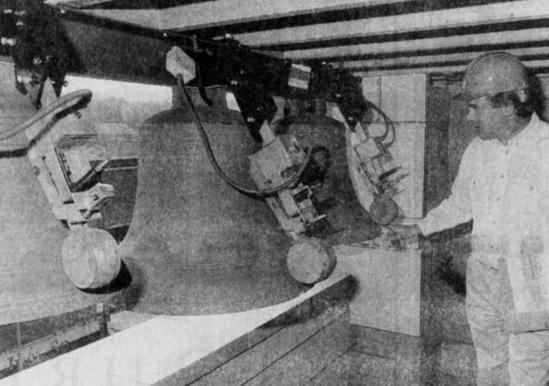 |
|
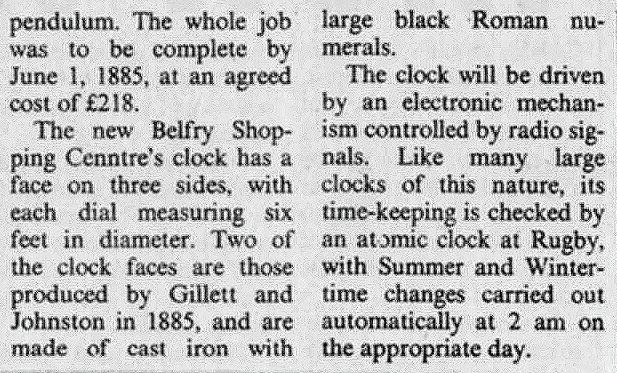 |
| The bells and strikers (Photo from Surrey Mirror of
August 1991 provided by James Bloomfield) |
|
(Surrey Mirror article of
August 1991 provided by James Bloomfield)) |
| |
|
|
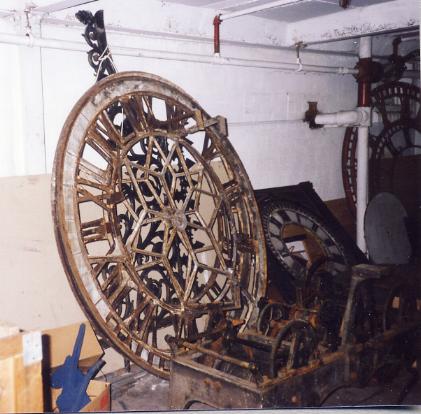 |
|
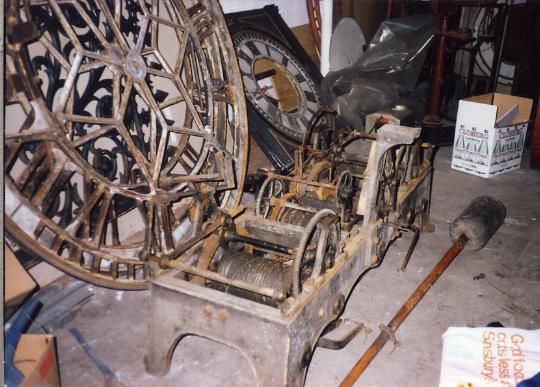 |
| |
|
|
 |
|
As stated in the above article the clock
was discovered at Sotherbys and collected from there by
Gillett & Johnson, the original makers. These photos
taken by James Bloomfield show the clock in store and the
van that carried it back to Croydon before refurbishment
and installation at the Belfry, Redhill. |
| |
|
|
| Contrasting
opinions about the new Belfry clock in letters to the
Surrey Mirror (Cutting
courtesy James Bloomfield) |
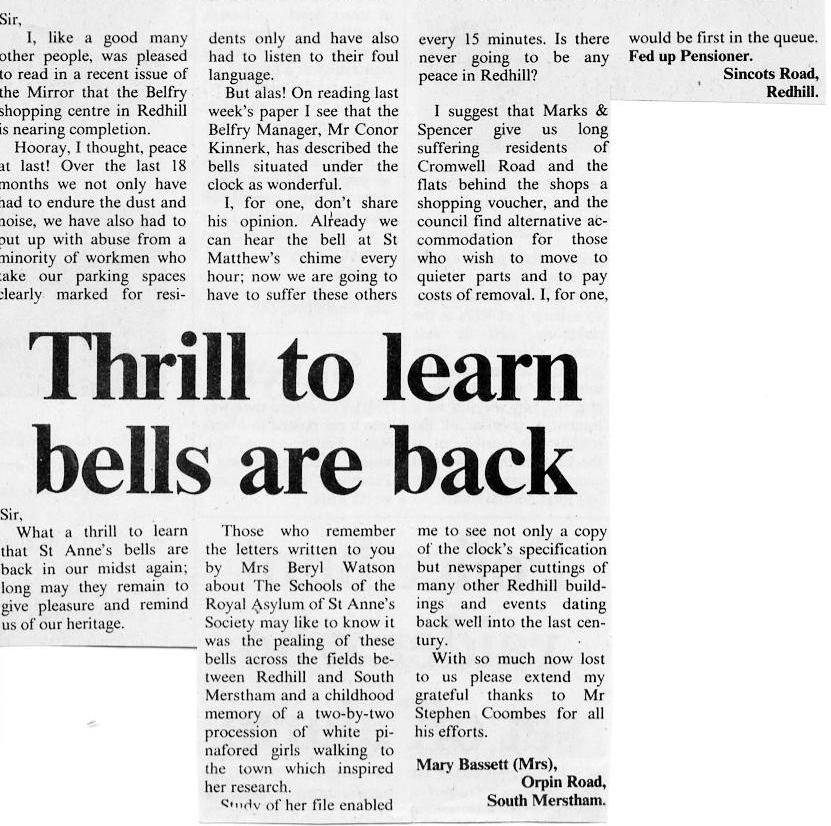 |
| |
| |
| The
above information about the St Anne's clock was supplied
above by Mr James Bloomfield and much more from him
appears below. Here in his own words is how he became
interested in St Anne's. |
| |
I
recently discovered your Redhill history website, and was
particularly interested in the section on St Anne's. As a
fifteen year old schoolboy at the nearby Warwick School
in 1987, I became interested in the building as it was
being demolished. I started to make a photographic record
of the demolition and research the
building's history. Somehow, I think via a teacher,
I made contact with Beryl Watson, who lived in Nutfield
Road, Merstham. I remember going there for the first
time, she wearily opened the front door. "Hello Mrs
Watson, I've come to talk to you about St Anne's".
With that, the door flew open and I was more or less
dragged in. We waded through piles of cuttings and
papers and for about 3 hours, with hardly pause for
breath she told me virtually everything there was to
know. I remember the whereabouts of the Chapel stained
glass windows were of considerable concern to her.
In later weeks though, I was able to provide her
with some interesting information.
Sussex Architectural
Salvage did indeed remove the main turret from the clock
tower, (I provided Mrs Watson with that Surrey
Mirror photo on your site!!) along with 2 smaller
turrets from the wings, terracotta date stones and
various decorative stone work. It was all sold at an
auction at Sotherby's in Billingshurst, on 31st May
1988, which I attended. I still have the catalogue
and made a note of the sale price of each item as it
sold. The main turret was withdrawn from sale, restored,
and sold at a later date. The 2 clock faces, three
bells and cock mechanism were salvaged by Gillet and
Johnson Ltd of Croydon who made the clock originally. I
went to their office and was provided with a copy of the
original order for the clock made on 2nd May 1885 by
Robert Field Esq. JP, including fitting, for the sum of
£218. Gillet and Johnson restored the faces and made a
replica face and they are indeed fitted along with the be
James
Bloomfield - December 2010 |
| |
|
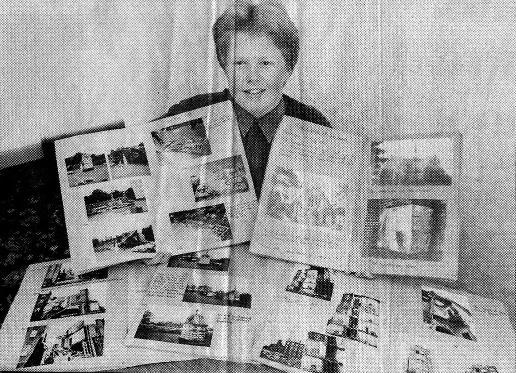 James is shown above. The photo
and text appeared in a Surrey Mirror article from August
4th 1988
|
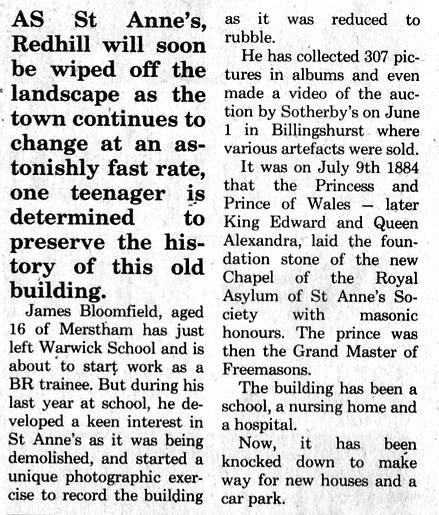 |
| |
|
| |
|
| The Demolition of St Anne's as
recorded by James Bloomfield |
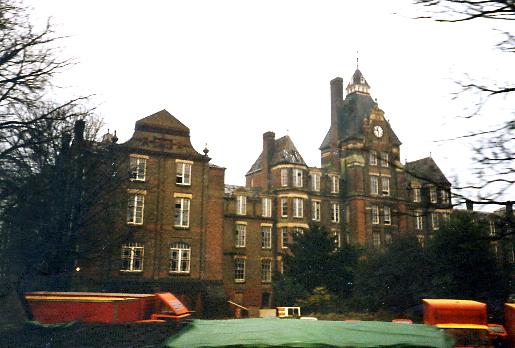 |
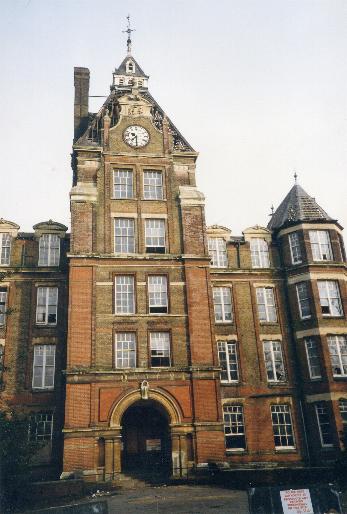 |
| Early
December 1987. The first thing to happen was the roof
slates were removed for salvage, you can see them piled
up on the roof. Demolition began at the rear, namely the
school hall, followed by the northerly wing. Many of the
bricks were also salvaged for re-use. (Photos courtesy James
Bloomfield) |
| |
|
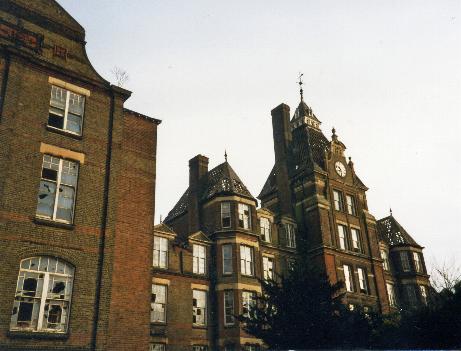 |
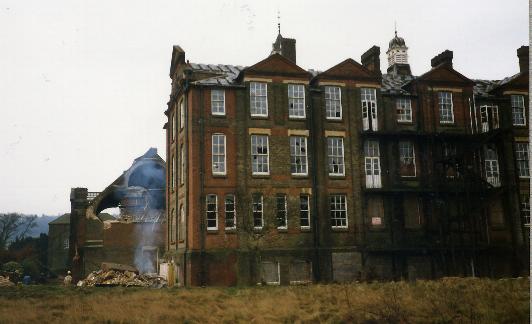 |
| Early December 1987 (Photos courtesy James
Bloomfield) |
| |
|
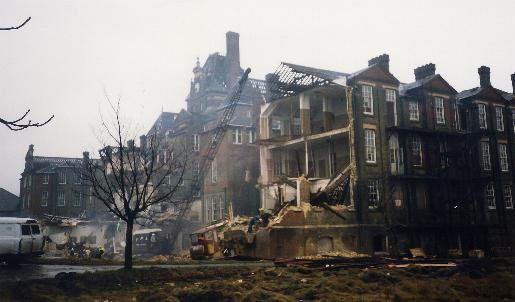 |
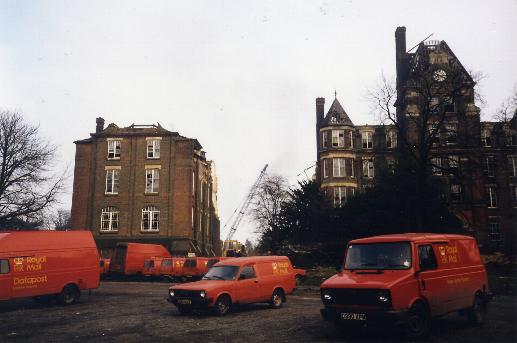 |
| 17th December 1987 |
Taken from the Post Office
vehicle park 17th January 1988 |
| (Photos
courtesy James Bloomfield) |
| |
|
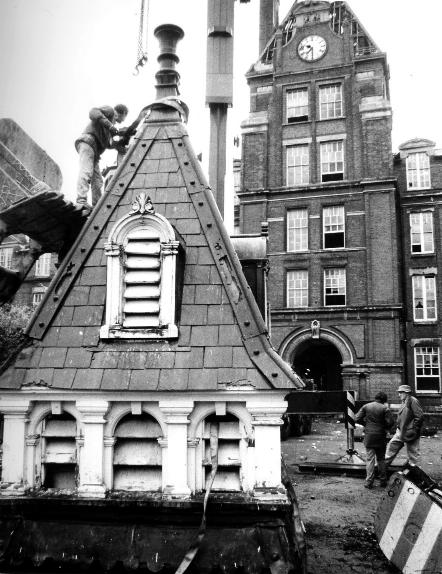 |
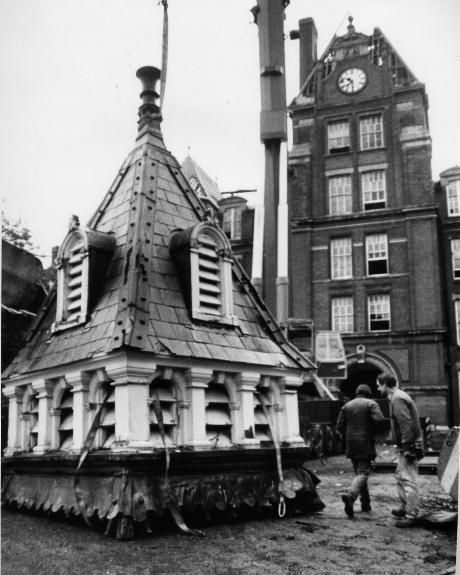 |
| The lowering of the turret,
early December 1987.
|
| |
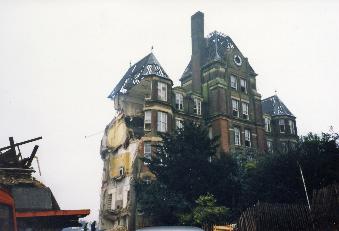 |
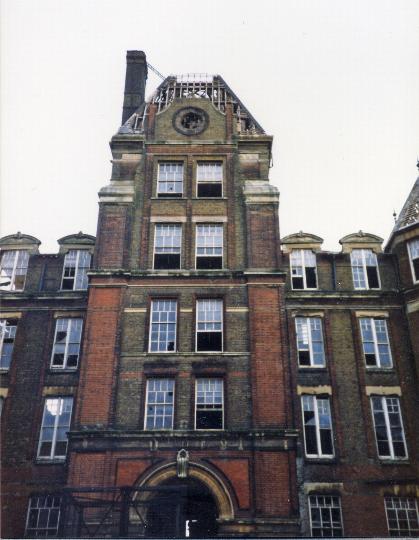 |
| 30th January
1988. James Bloomfild recollects that at lunchtime the
glass was being smashed out of the clock faces as he took
the first picture, and by the end of school that day the
turrets had been lowered to the ground by rope. He
arrived to see the mechanism had been loaded in the
Gillett and Johnston van and the faces strapped to the
top (picture appears further up this page). He spoke to
the driver, and disputes the comments in the Surrey
mirror article (also appearing above) about the clock
going missing and being tracked down later. He wonders if
it was the bells that went missing for a while rather
than the clock or faces. He says he never did see
the bells even when he went to the Gillett and Johnston
workshop. If they were still in the bell turret when it
was taken to Sotherby's then that would tie in.(Photos courtesy James
Bloomfield) |
| |
|
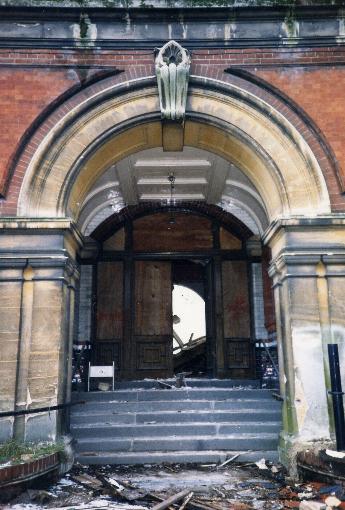 |
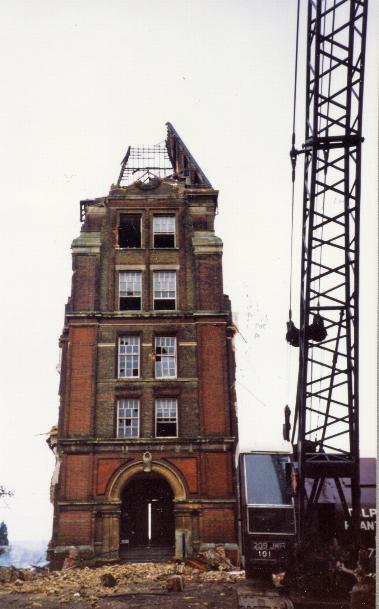 |
| Main entrance 30th January 1988 |
13th February 1988 |
| (Photos
courtesy James Bloomfield) |
| |
|
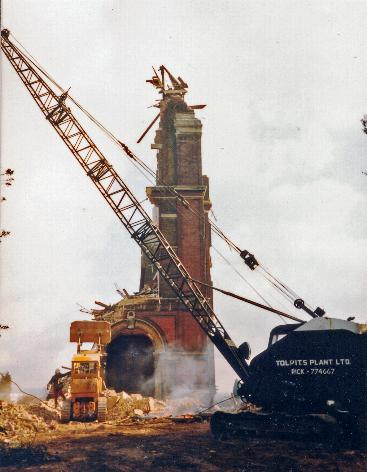 |
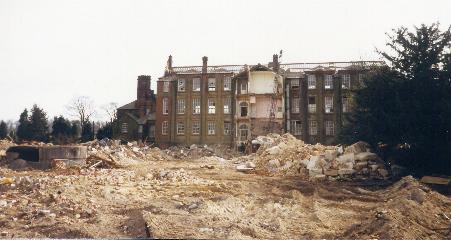 |
| 25th February 1988 |
9th March 1988 |
| (Photos
courtesy James Bloomfield) |
| |
|
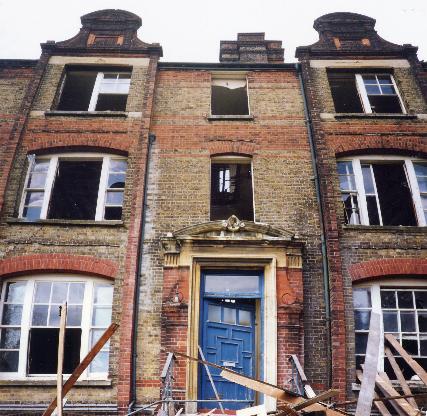 |
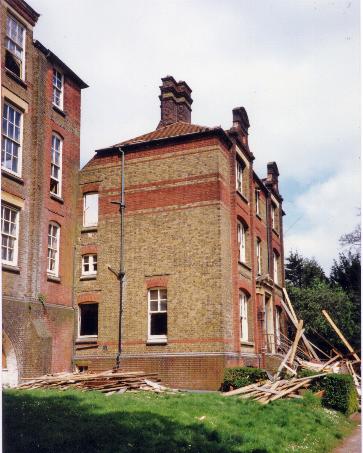 |
| 23rd April
1988. The
Headmaster's house. This was still lived in until a few
weeks before demolition |
| (Photos
courtesy James Bloomfield) |
| |
|
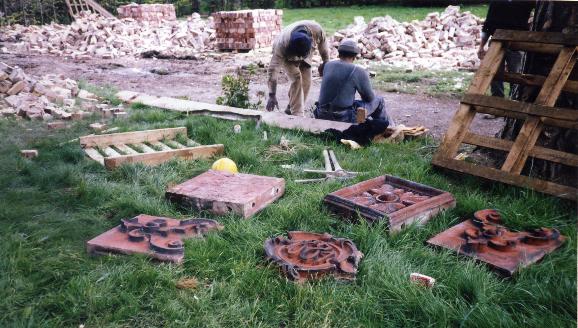 |
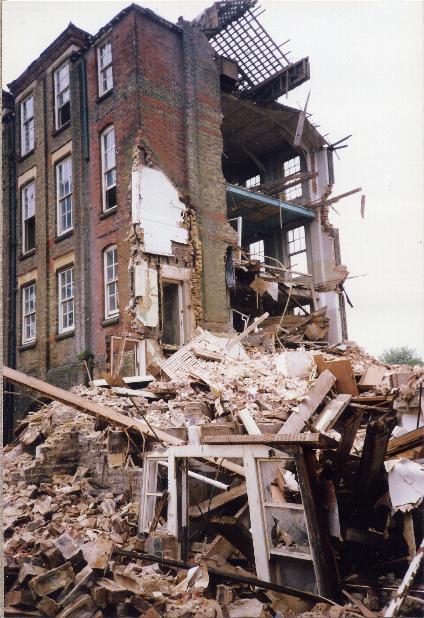 |
| 5th May 1988. One of the date plaques had just been
removed. The workers were cleaning up and stacking bricks
ready for collection. |
18th May 1988. Headmaster's
house reduced to rubble. Note the doorway at first floor
level giving direct access into the wing. |
| (Photos
courtesy James Bloomfield) |
| |
|
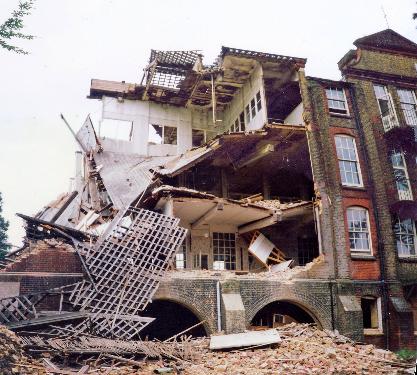 |
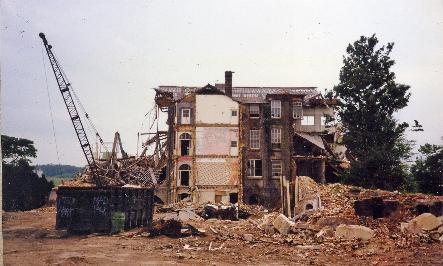 |
| 17th and 18th
May 1988. Six months after work started it's almost over (Photos courtesy James
Bloomfield) |
| |
|
| |
|
|
| The sale of items
from the St Anne's building at Sotherbys on 1st June 1988 |
 |
|
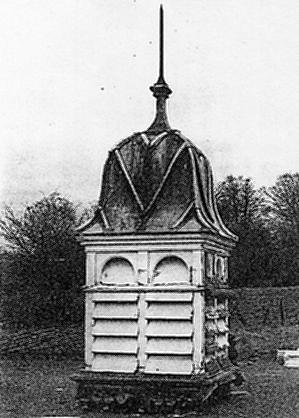 |
| Many parts of the building were
sold at auction. A pair of terracotta wall plaques, of
which the item pictured was one, went for £400. (photo Beryl Watson) |
|
This wood and lead flashed dome
was sold for £2,000 (Photo Beryl Watson) |
| |
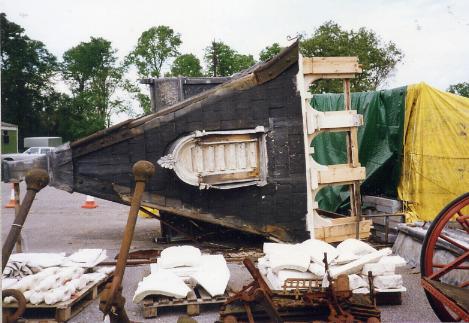 |
|
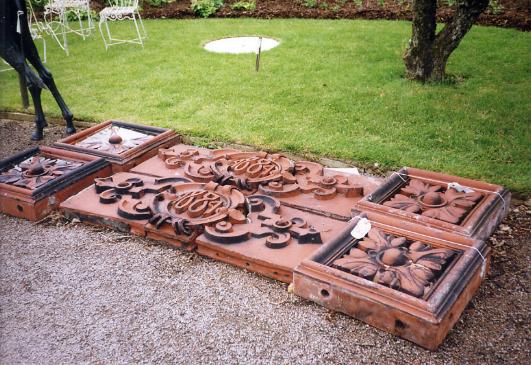 |
| The mail bell turret under
restoration, see all the new woodwork at the base. This
item was withdrawn from sale. (Photo James Bloomfield) |
|
Terrcotta date plaques. These
were located on the gable ends of the wings. Three were
for sale. Workers at the site said that the council kept
one set. No more is known about this. (Photo James Bloomfield) |
| |
|
|
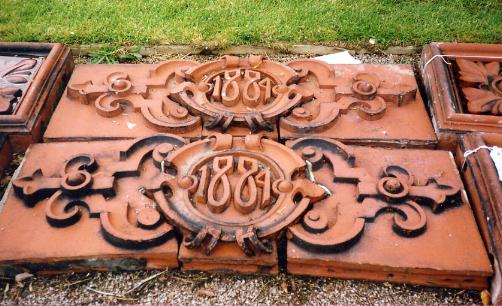 |
|
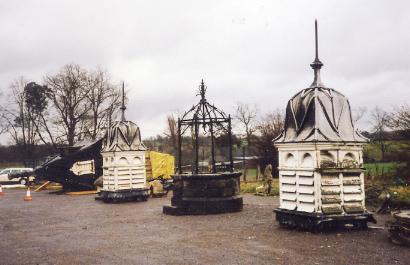 |
| Another view of the terracotta
date plaques. (Photo James Bloomfield) |
|
The
domes from the roof of each wing.. (Photo James Bloomfield) |
| |
|
|
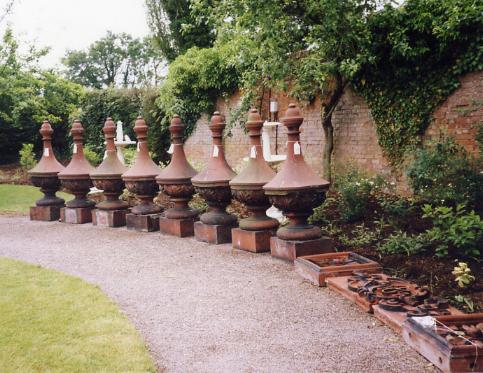 |
|
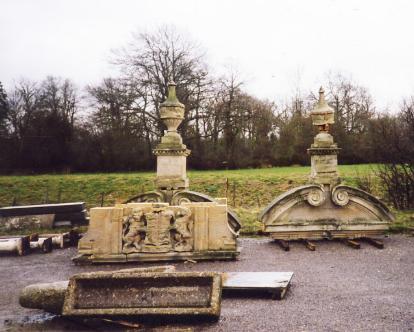 |
| Terracotta finials. These were
located on each corner of the wings (Photo James Bloomfield) |
|
Sandstone pediments from above
the clocks. Coat of arms for the front clock.
(Photo
James Bloomfield) |
| |
|
|
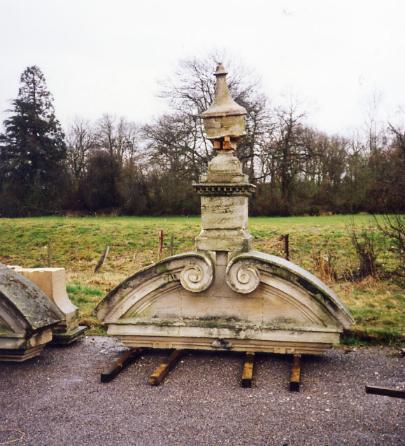 |
|
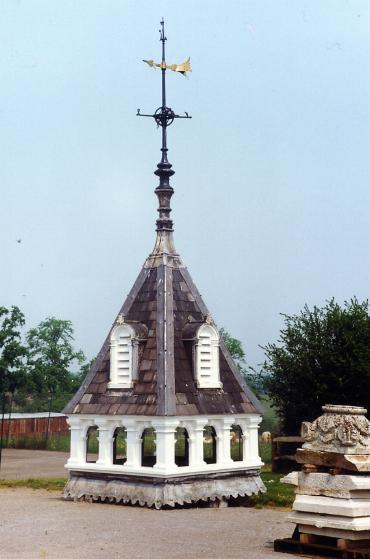 |
| Plain pediment from the rear of
the clock. Not in good condition (Photo James Bloomfield) |
|
The restored bell turret some
months after the sale. Sale price unknown. (Photo James Bloomfield) |
| |
|
|
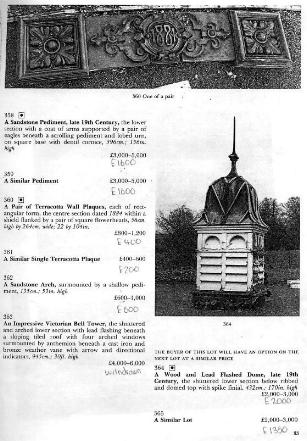 |
|
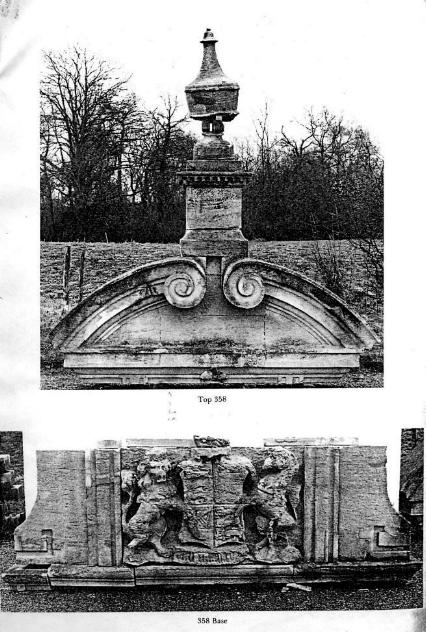 |
Page from the sale catalogue
annotated with sale prices
(Courtesy
James Bloomfield) |
|
Another page showing the
sandstone pediments from the front of the clock. (Courtesy James Bloomfield) |
| |
|
|
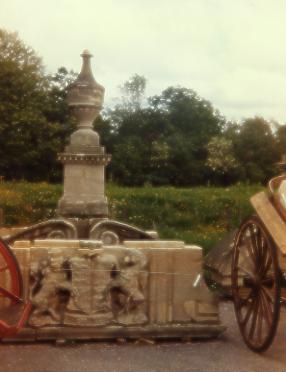 |
|
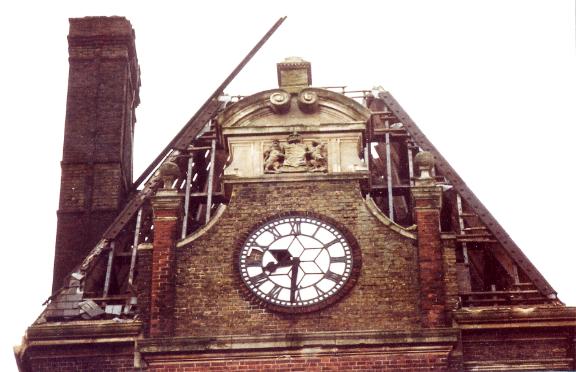 |
| Another picture of demolition
material on sale. The pony trap on the right was a part
of the sale but was nothing to do with St Anne's. (Photo courtesy Beryl Watson) |
|
(Photo James Bloomfield) |
| |
|
|
| |
|
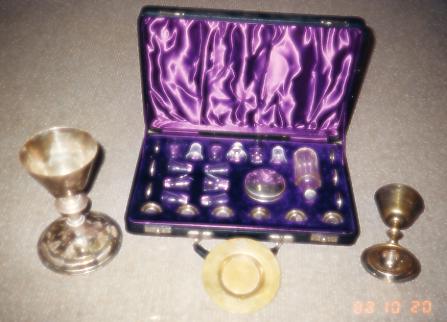 |
| |
|
The St
Anne's communion set ( Beryl
Watson) |
| |
|
|
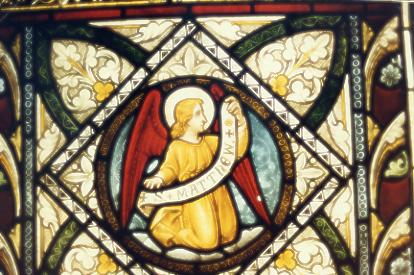 |
|
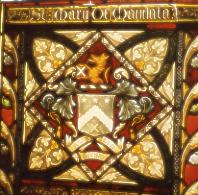 |
| This stained glass panel from St
Anne's chapel is one of two base panels from lancet
windows that are in store at the Stained Glass Museum at
Ely Cathedral. It measures 62cm x 63cm and depicts an
angel with a scroll inscribed 'St Matthew'. |
|
Another of the stained glass
windows from St Anne's
(These two
photoss supplied to Beryl Watson by the curator of the
Stained Glass Museum at Ely |
| |
|
|
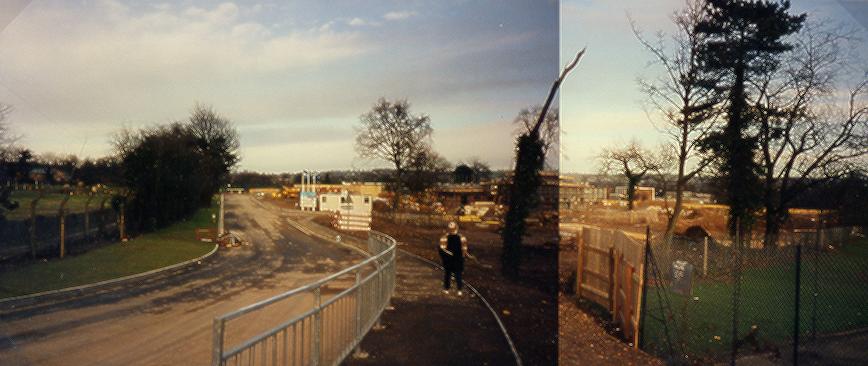 |
| A
picture (actually two joined together) taken in the 1990s
when walking through the St Anne's site. Dwellings were
in the course of erection where the old Victorian
institution that is the subject of this page once stood. |
| |
|
|
References: -
Surrey Mirror Aug. 26th 1882- Long
article about proposed St Anne's building
Surrey Mirror Sept. 16th 1882 - General St Anne's
article
Surrey Mirror May 19th 1883 - St Anne's, laying of
foundation stone
Times 4th February 1936 Article about St Anne's
Surrey Mirror 1st October 1937 Obituary of the Rev
W.J.Perry.
Surrey Mirror 24th June 1949 Article about St Anne's
headmaster, the Rev W.J.Perry
Various School magazines
A Celebration of Fengates Road by Andrew and Sarah
Lewis
Acknowledgements Many thanks are due to : -
Mrs Beryl Watson, a resident of Merstham, who did much
work on the history of St Anne's. A collection of her
material was given to me a number of years ago after her
death. I understand that Mrs Watson saw the Foundling
Children crocodiling through Redhill in the 1930s and the
sight aroused her interest in their school and the
history of the St Anne's building. I hope that she would
approve of what I have since laid out here. AJM 24.1.2005
Mike Ingram, some time resident of Reigate, who kindly
lent a number of St Anne's magazines (Boys' side) dating
from No.1 in 1902 to No.27 in 1912, from which some of
the pictures in this chapter came.
Jan Dixon and her father, Roger Clarke, who provided
information about their forebear Christopher Gough,
Engineer at St Anne's, and gave me access to items from
their rich family chest.
The Surrey Mirror and the Times Newspaper.
Joanna and Stephen Parkinson for making
available in 12010 and 2011 a number of Perry family
albums containing many pictures of St Anne's staff, boys
and girls (the first seen of St Anne's girls)
James Bloomfield, who made a
significant collection of information and photos at the
time of the demolition of St Anne's, as well as the
subsequent sale of its architectral treasures, and then
shared that material in December 2010, allowing it to be
shown above.
|
| |
| |
| EMAILS FROM
PEOPLE SEEKING INFORMATION ABOUT ST ANNE'S |
Revd Charles
Denis Simons.
June 2009 |
|
I
am researching my family tree and have come across
Charles Ivan Simons as a member of the school in 1901 in
the Census RG13/628 on Page 14. He was 14 years old from
Northamptonshire. He was in fact from a farming family at
Yelvertoft and his father John Simons died at age 37 in
1890. This perhaps the reason he came to the
school? Charles Ivan Simons is my Great Grand Uncle
and was with the Royal Engineers and fought in France in
World War l where he attained the rank of Captain. He was
decorated with the Military Cross. Here's an abstract
from the London Gazette of 13 May, 1918. 5703 "T.LT
Charles Ivan Simons, R. E. For conspicuous gallantry and
devotion to duty when in charge of gas operations. He
reconnoitered the position under heavy fire, and
organised the installation and firing of his projectiles
with great success under most difficult conditions. He
showed great coolness and skill." I have been
unable to find any other information on him and am trying
to find if he married and had any children; indeed if he
survived WWl. |
| |
|
|
Kevin P Strelley
October 2007 |
|
For the past 15 years I have been
researching my family tree, and after looking at the 1861
census, came across a John Henry Strelley who was listed
in the census of that year at the school, Royal Asylum of
the ST Anne Society. I would like to know is there any
way of tracing who his father was ? etc etc. would you
know of any groups who would know ?. any help you can
give would be great. |
| |
|
|
Laura Martin
June 2007 |
|
I am a history graduate currently
involved in researching my family. The information
that my grandfather provided me with was that his mother;
Florence Mabel Campe, attended St. Anne's boarding
school for girls at around 1905. On the webpage the
details seemed mainly to refer to the boys school and I
wanted to confirm that there was a girls school at this
site. If you could provide me with any further
information or know of any records available I would be
most grateful.
|
| |
|
|
Gaynor Howard
(nee Thomas)
September 2007 |
|
I have read your site with great
interest, as my father was a pupil at St Ann(e)'s between
1891, (following the untimely death of his father), and
1897. He is boy 171, THOMAS;CHARLES S. bn. August 1st
1882. I believe his uncle or aunts purchased his place,
and all his siblings who were old enough, were sent to
other schools, one to Manchester Merchant Taylor School,
another to Dean Close in Gloucester Some five years ago, I contacted Jan
Dixon, who sent me a great deal of information, but I
have been delighted to read so much extra information on
your site. Sadly, my father spoke little about his time
there. I still have his prize,(a copy of David
Copperfield, for "Band"), and also the flute
which was obviously the instrument he played. While the
regime was pretty tough it certainly honed my father's
strong faith and deep sense of morality. Of all his
siblings he was the one who looked after his mother in
her final years, putting his own life 'on hold', and I
really think he understood his mother's privations
in widowhood better than his brothers and sisters because
of the atmosphere in which he had spent his formative
years at St Ann's. My father volunteered for WW1,and
arrived back to find his wife seriously ill. She died and
he remarried in 1930. I am his only child and he
was the best of fathers. |
| |
|
|
Graham
Bartlett.
May 2006 |
|
Although
I once lived in Redhill my main interest is that my
fathers family, the Bartletts and Earles lived there and
I am putting my family tree info on the computer and have
made a DVD about them, one section of which covers
Redhill. My father, John Bartlett worked for Foxboro soon
after it opened until the nineties. I remember playing
tennis on their courts, and attending the Christmas
parties there as a child - someone must have had
connections with the record industry because they always
gave away lots of '45s' to all the children. I have sent
my father a link to your Foxboro page which I am sure he
will be interested in, and my wife a link to the Linnell
family page as she became interested in them after buying
one of his paintings.
The St Annes picture I include was from my grandfather,
Bert Bartlett, who worked at St. Annes as a boilerman /
handyman and he met his second wife, Mary Fletcher there
who was a cook. The picture which was on a postcard was
discovered among his possessions after he died in 1989.
My grandfather also worked for the East Surrey Water
Company in Redhill, I remember their site on the corner
of Frenches Road and London Road.
|
| |
|
|
| |
|
| Photos of pupils and staff
dating from 1913-18 from albums handed down through
generations of the Perry family are shown on a separate
page. Many of the subjects are named. Previously no
pictures of girls or female staff at St Anne's had been
seen. Grateful thanks to Joanna Parkinson and her husband
Stephen for making them available. |
| |
|
| View the photographs |
| |
| |
|
|

